Itinerary
The port city of Fremantle is a jewel in Western Australia’s crown, largely because of its colonial architectural heritage and hippy vibe. Freo (as the locals call it) is a city of largely friendly, interesting, and sometimes eccentric residents supportive of busking, street art, and alfresco dining. Like all great port cities, Freo is cosmopolitan, with mariners from all parts of the world strolling the streets—including thousands of U.S. Navy personnel on rest and recreation throughout the year. It’s also a good jumping-off point for a day trip to Rottnest Island, where lovely beaches, rocky coves, and unique wallaby-like inhabitants called quokkas set the scene.Modern Fremantle is a far cry from the barren, sandy plain that greeted the first wave of English settlers back in 1829 at the newly constituted Swan River Colony. Most were city dwellers, and after five months at sea in sailing ships they landed on salt-marsh flats that sorely tested their fortitude. Living in tents with packing cases for chairs, they found no edible crops, and the nearest freshwater was a distant 51 km (32 miles)—and a tortuous trip up the waters of the Swan. As a result they soon moved the settlement upriver to the vicinity of present-day Perth.Fremantle remained the principal port, and many attractive limestone buildings were built to service the port traders. Australia’s 1987 defense of the America’s Cup—held in waters off Fremantle—triggered a major restoration of the colonial streetscapes. In the leafy suburbs nearly every other house is a restored 19th-century gem.
Day itinerary:
Coming in at number seven on Lonely Planet’s list of best places to live, Fremantle has finally begun to shake off the shadow of neighbouring big brother Perth. With just 20 kilometres separating the two cities, Perth, with its happy hippie vibe has long been the big pull for visitors to the region. But Fremantle’s colourful past and bright future gives Perth as good as it gets. The coastal city has undergone a complete revamp since the America’s Cup thrust Fremantle into the spotlight in 1987. Over AUS$1.3 billion has been poured into revamping the city, and the fruits of the city’s labour are ripe for picking. Investment in the arts has brought Fremantle to the fore of thriving urban culture, while generous grants for small businesses has led to groovy live-music rooms, hipster bars, boutique hotels, left-field bookshops, craft-beer breweries, Indian Ocean seafood shacks amid the buskers and beaches. If that doesn’t not sound like your glass of beer, we guarantee a stroll along the wooden riverside walkway will change your mind. The city also enjoys another, rather different status. Fremantle was one of Australia’s penal cities, vestiges of which can still be found in Fremantle Prison. Almost 10,000 convicts were condemned to life imprisonment here between 1850 and 1868, but the prison remained in use until 1991. Today, the memorable sandstone building is a UNESCO World Heritage Site and at just 15 minutes from port is well worth a visit. Just don’t forget your get out of jail free card.
Day itinerary:
The key location of Exmouth along the Western Australian coast has meant that this area lays claim to many interesting historical landmarks, industries and research stations, including the old Navy Pier and the Learmonth Solar Observatory, which is jointly operated by the IPS Radio and Space Services and by the US Air Force. In fact, Exmouth was built in 1967 to serve the American Naval Communication Station but has since become a tourist base for visits to the Cape Range National Park and Ningaloo Marine Park. The cloud-free atmosphere especially suited for VLF (very low frequency) transmissions and the prolific marine wildlife has helped to attract tourism. But the infrastructure still remains rather limited.
Traffic in the Broome Harbour (a very busy working harbour) is restricted, requiring special permits for all vehicles accessing the pier area. Guests are not permitted in this area on an individual basis. In order to make disembarkation as smooth as possible Silversea will be providing a group motorcoach transfer from the pier to the airport. This transfer will depart shortly after the ship is cleared. Exact timings will be communicated by the ship’s staff.Guests who do not wish to go to the airport immediately following disembarkation will be transferred to Pearl Luggers, located 10 – 15 minutes from the airport, where taxis are available for hire.
Day itinerary:
Gateway to the oldest and most elusive of all Australia’s nine regions, Broome is where your Kimberley adventure begins. The ancient landscape has long held travellers spellbound: The Kimberley is three time larger than England but has a population of just 35,000, is over 65,000 years old and is home to 2,000 km of coastline. Almost impenetrable, incredibly remote, the red baked earth, prolific wildlife, majestic canyons and swimming holes are the stuff of Australian wilderness dreams. English explorer William Dampier was the first explorer to set foot in Broome in 1668. However, the land had long been used as a trading route between east and west Kimberley for Aboriginal families. These semi-nomadic tribes respected strict unwritten rules regarding ownership of the land. The Yawuru people remain the Native Title holders for the township of Broome to this day. Broome itself has over 84 Aboriginal communities affiliated to it, 78 of which are considered remote. The city grew from its nascent pearling industry of the late 19th century. Pearl diving was dangerous in the waters surrounding Broome and for many years divers were limited to Aboriginal slaves, skin divers who faced cyclones, sharks, crocodiles, ear and chest infections in order to bring up as many pearl shells as possible for their masters. Natural pearls were rare and extremely valuable, and when found, were placed in a locked box. At the peak of its industry, around 1914, Broome was responsible for 80% of the world’s pearl trade.
Darwin is Australia’s most colorful, and exotic, capital city. Surrounded on three sides by the turquoise waters of the Timor Sea, the streets are lined with tropical flowers and trees. Warm and dry in winter, hot and steamy in summer, it’s a relaxed and casual place, as well as a beguiling blend of tropical frontier outpost and Outback hardiness. Thanks to its close proximity to Southeast Asia and its multicultural population it also seems more like Asia than the rest of Australia. Darwin is a city that has always had to fight for its survival. The seductiveness of contemporary Darwin lifestyles belies a history of failed attempts that date from 1824 when Europeans attempted to establish an enclave in this harsh, unyielding climate. The original 1869 settlement, called Palmerston, was built on a parcel of mangrove wetlands and scrub forest that had changed little in 15 million years. It was not until 1911, after it had already weathered the disastrous cyclones of 1878, 1882, and 1897, that the town was named after the scientist who had visited Australia’s shores aboard the Beagle in 1839. During World War II it was bombed more than 60 times, as the harbor full of warships was a prime target for the Japanese war planes. Then, on the night of Christmas Eve 1974, the city was almost completely destroyed by Cyclone Tracy, Australia’s greatest natural disaster. It’s a tribute to those who stayed and to those who have come to live here after Tracy that the rebuilt city now thrives as an administrative and commercial center for northern Australia. Old Darwin has been replaced by something of an edifice complex—such buildings as Parliament House and the Supreme Court all seem very grand for such a small city, especially one that prides itself on its casual, outdoor-centric lifestyle. Today Darwin is the best place from which to explore Australia’s Top End, with its wonders of Kakadu and the Kimberley region.
Day itinerary:
Australia’s capital of the north is a uniquely tropical city and a historically isolated outpost of this vast diverse country. Reaching up towards the equator a full 2 000 miles from Sydney and Melbourne the city was named in honour of Charles Darwin by the British settlers who established a frontier outpost here. With a unique history beautiful islands nearby and a palette of sizzling Pacific flavours colourful Darwin is an enchanting and exotic Australian destination. Crocodiles patrol the jungled waterways and tropical rainforests around Australia’s gateway to the Top End. Explore via airboat to look down on the veiny waterways of the mist-laced Kakadu National Park. The sounds of chattering birdlife and the gentle splash of fountains and waterfalls will fill your ears in George Brown Darwin Botanic Gardens. Soak it all in before kicking back and relaxing with a picnic and a crackling barbecue. The sunshine and famous tropical pink sunsets mean many visitors naturally gravitate to the city’s soft sands to relax at spots like pretty Mindil Beach as evening approaches. The adjoining market is filled with souvenirs and crafts stands and is the perfect great place to enjoy some fiery Asian flavours. Stroll the stalls grab some food and crack open an ice-frosted beer as the sunset show begins. It may be remote but Darwin found itself on the front line during the Pacific War as the Japanese air force unloaded their bombs onto the city in 1942.
Day itinerary:
An island of startling contradictions and contrasts Lombok exudes an aura of the staid and the rural a genteel way of life in a quiet backwater. Located to the east and across a deep strait from its illustrious neighbor Bali the island of Lombok offers unique culture beautiful landscapes and a far less frenetic pressured atmosphere than Bali. However savvy travelers agree that Lombok’s calm existence may soon come to an end as it is fast becoming the new “in place” after Bali. The island was once ruled by a series of Sasak princes who spent their time fending off successive invasions from Sumbawanese and Makassarese attackers. In 1740 the Balinese established a stronghold here and imposed their culture on the Sasaks. Later Lombok came under Dutch rule until the country achieved independence. The western part of the almost circular island is well irrigated by mountain streams and artesian springs. Here Balinese and Sasaks have sculpted handsome rice terraces Hindu temples vie for attention with glistening white mosques rising from picturesque rural villages. More dramatic is the southern coast with beautiful sandy bays set between rocky outcrops. Most of Lombok’s attractions are concentrated in the western district of the island within a nine-mile radius of the capital Mataram. Members of Lombok’s polyglot population – Sasak Balinese Chinese and Arab – continue their laid-back traditional ways.
Bali really is as alluring as everyone says. This island, slightly bigger than Delaware, has it all: beaches, volcanoes, terraced rice fields, forests, renowned resorts, surfing, golf, and world-class dive sites. But what sets Bali apart from other nearby tropical destinations is Balinese tradition, and villagers dedicated to celebrating it. The hundreds of temples, dances, rituals, and crafts linked to their ancient Hindu faith aren’t a show for tourists, but a living, breathing culture in which visitors are warmly received by the Balinese, who cherish their own identities.
Day itinerary:
Bali. A.k.a. Island of the Gods, Land of a thousand temples or the World’s last paradise. As superlative as these monikers may sound, they do not do justice to the actual reality of the island. Bali is as good as everyone says – verdant mountains with terraced rice fields in one direction, black sand beaches in another and captivating people that will leave even the most seasoned traveller humbled. If you’re looking for a Garden of Eden that really does have it everything, Bali ticks all the boxes. The rich and diverse culture of the island is what sets Bali apart from Indonesia’s (many) other tropical paradises. The country’s estimated 10,000 Buddhist-Hindu temples, with their daily offerings of lotus flowers and fruit are testament to the gentleness of the islander’s belief. Then there is the vibrant arts and crafts scene, notably in Ubud in the centre of the island, but prolific everywhere. Ideal souvenirs to bring back range from gorgeous silver jewellery to intricate wood carvings. Additionally, do try to see a traditional dance if possible, particularly if accompanied to local gamelan music. No one could mention Bali without mentioning the food. Dishes range from elaborate meals to street food bites, but all are without exception ambrosia. Do not miss out on tasting a succulent chicken satay, betutu (apparently the King’s favourite meal) and sambal matah. But whatever you decide to discover, you can be assured of a taste sensation that will remain with you long after you have returned home.
The main island of Singapore is shaped like a flattened diamond, 42 km (26 miles) east to west and 23 km (14 miles) north to south. Near the northern peak is the causeway leading to West Malaysia—Kuala Lumpur is less than four hours away by car. It is at the southern foot where you will find most of the city-state’s action, with its gleaming office towers, working docks, and futuristic “supertrees,” which are solar-powered and serve as vertical gardens. Offshore are Sentosa and over 60 smaller islands, most uninhabited, that serve as bases for oil refining or as playgrounds and beach escapes from the city. To the east is Changi International Airport, connected to the city by metro, bus, and a tree-lined parkway. Of the island’s total land area, more than half is built up, with the balance made up of parkland, farmland, plantations, swamp areas, and rain forest. Well-paved roads connect all parts of the island, and Singapore city has an excellent, and constantly expanding, public transportation system. The heart of Singapore’s history and its modern wealth are in and around the Central Business District. The area includes the skyscrapers in the Central Business District, the 19th-century Raffles Hotel, the convention centers of Marina Square, on up to the top of Ft. Canning. Although most of old Singapore has been knocked down to make way for the modern city, most colonial landmarks have been preserved in the CBD, including early-19th-century buildings designed by the Irish architect George Coleman.
Day itinerary:
Advanced, airy and elevated, Singapore is a spectacular, futuristic vision of utopian city life. A healthy population of almost six million call it home, but this is a city designed with space to breathe, and gorgeous outdoor parks, massive indoor greenhouses and beautiful recreational spaces spread between the City of Gardens’ skyscrapers and soaring structures. Once a quiet fishing village, now a glistening island city-state and an international beacon of science, education and technology. Singapore is almost intimidatingly clean – and the hyper-efficient public transport system whips residents and visitors across the city’s neighbourhoods in a heartbeat. Glorious fountains and audacious skyscrapers loom up – nodding to traditional feng shui beliefs – and putting on dazzling illuminated displays after dark. The lush green botanical gardens are a spectacular UNESCO World Heritage Site, covering 52 hectares and decorated with impressive colourful orchids. Or breathe in more of the freshest air by heading up to wander the canopy strung bridges of MacRitchie Reservoir Park. Head for the iconic Marina Bay – a landmark of the city crowned by three interconnected towers, which watch out over island sprinkled waters. Jaunt between Little India and the atmospheric Chinatown in minutes, where beautiful temples – like the Chinese Thian Hock Keng Temple and Hindu Sri Mariamman Temple add rich cultural intrigue. Singapore’s cuisine is a mouthwatering fusion of its Indian, Chinese, Indonesian, and Malay influences, taking and enhancing the best of each. Enjoy dishes in towering restaurants, or toast the glowing skyline with the city’s eponymous gin-soaked cocktail – a Singapore Sling.
The main island of Singapore is shaped like a flattened diamond, 42 km (26 miles) east to west and 23 km (14 miles) north to south. Near the northern peak is the causeway leading to West Malaysia—Kuala Lumpur is less than four hours away by car. It is at the southern foot where you will find most of the city-state’s action, with its gleaming office towers, working docks, and futuristic “supertrees,” which are solar-powered and serve as vertical gardens. Offshore are Sentosa and over 60 smaller islands, most uninhabited, that serve as bases for oil refining or as playgrounds and beach escapes from the city. To the east is Changi International Airport, connected to the city by metro, bus, and a tree-lined parkway. Of the island’s total land area, more than half is built up, with the balance made up of parkland, farmland, plantations, swamp areas, and rain forest. Well-paved roads connect all parts of the island, and Singapore city has an excellent, and constantly expanding, public transportation system. The heart of Singapore’s history and its modern wealth are in and around the Central Business District. The area includes the skyscrapers in the Central Business District, the 19th-century Raffles Hotel, the convention centers of Marina Square, on up to the top of Ft. Canning. Although most of old Singapore has been knocked down to make way for the modern city, most colonial landmarks have been preserved in the CBD, including early-19th-century buildings designed by the Irish architect George Coleman.
Day itinerary:
Advanced, airy and elevated, Singapore is a spectacular, futuristic vision of utopian city life. A healthy population of almost six million call it home, but this is a city designed with space to breathe, and gorgeous outdoor parks, massive indoor greenhouses and beautiful recreational spaces spread between the City of Gardens’ skyscrapers and soaring structures. Once a quiet fishing village, now a glistening island city-state and an international beacon of science, education and technology. Singapore is almost intimidatingly clean – and the hyper-efficient public transport system whips residents and visitors across the city’s neighbourhoods in a heartbeat. Glorious fountains and audacious skyscrapers loom up – nodding to traditional feng shui beliefs – and putting on dazzling illuminated displays after dark. The lush green botanical gardens are a spectacular UNESCO World Heritage Site, covering 52 hectares and decorated with impressive colourful orchids. Or breathe in more of the freshest air by heading up to wander the canopy strung bridges of MacRitchie Reservoir Park. Head for the iconic Marina Bay – a landmark of the city crowned by three interconnected towers, which watch out over island sprinkled waters. Jaunt between Little India and the atmospheric Chinatown in minutes, where beautiful temples – like the Chinese Thian Hock Keng Temple and Hindu Sri Mariamman Temple add rich cultural intrigue. Singapore’s cuisine is a mouthwatering fusion of its Indian, Chinese, Indonesian, and Malay influences, taking and enhancing the best of each. Enjoy dishes in towering restaurants, or toast the glowing skyline with the city’s eponymous gin-soaked cocktail – a Singapore Sling.
The main island of Singapore is shaped like a flattened diamond, 42 km (26 miles) east to west and 23 km (14 miles) north to south. Near the northern peak is the causeway leading to West Malaysia—Kuala Lumpur is less than four hours away by car. It is at the southern foot where you will find most of the city-state’s action, with its gleaming office towers, working docks, and futuristic “supertrees,” which are solar-powered and serve as vertical gardens. Offshore are Sentosa and over 60 smaller islands, most uninhabited, that serve as bases for oil refining or as playgrounds and beach escapes from the city. To the east is Changi International Airport, connected to the city by metro, bus, and a tree-lined parkway. Of the island’s total land area, more than half is built up, with the balance made up of parkland, farmland, plantations, swamp areas, and rain forest. Well-paved roads connect all parts of the island, and Singapore city has an excellent, and constantly expanding, public transportation system. The heart of Singapore’s history and its modern wealth are in and around the Central Business District. The area includes the skyscrapers in the Central Business District, the 19th-century Raffles Hotel, the convention centers of Marina Square, on up to the top of Ft. Canning. Although most of old Singapore has been knocked down to make way for the modern city, most colonial landmarks have been preserved in the CBD, including early-19th-century buildings designed by the Irish architect George Coleman.
Day itinerary:
Advanced, airy and elevated, Singapore is a spectacular, futuristic vision of utopian city life. A healthy population of almost six million call it home, but this is a city designed with space to breathe, and gorgeous outdoor parks, massive indoor greenhouses and beautiful recreational spaces spread between the City of Gardens’ skyscrapers and soaring structures. Once a quiet fishing village, now a glistening island city-state and an international beacon of science, education and technology. Singapore is almost intimidatingly clean – and the hyper-efficient public transport system whips residents and visitors across the city’s neighbourhoods in a heartbeat. Glorious fountains and audacious skyscrapers loom up – nodding to traditional feng shui beliefs – and putting on dazzling illuminated displays after dark. The lush green botanical gardens are a spectacular UNESCO World Heritage Site, covering 52 hectares and decorated with impressive colourful orchids. Or breathe in more of the freshest air by heading up to wander the canopy strung bridges of MacRitchie Reservoir Park. Head for the iconic Marina Bay – a landmark of the city crowned by three interconnected towers, which watch out over island sprinkled waters. Jaunt between Little India and the atmospheric Chinatown in minutes, where beautiful temples – like the Chinese Thian Hock Keng Temple and Hindu Sri Mariamman Temple add rich cultural intrigue. Singapore’s cuisine is a mouthwatering fusion of its Indian, Chinese, Indonesian, and Malay influences, taking and enhancing the best of each. Enjoy dishes in towering restaurants, or toast the glowing skyline with the city’s eponymous gin-soaked cocktail – a Singapore Sling.
Kuala Lumpur, or KL as locals refer to it, intrigues visitors with its diversity and multicultural character. The city’s old quarter features stretches of shop houses that hint at its colonial past, while modern buildings—including the iconic Petronas Towers—give a glimpse of its modern financial ambitions. The city is filled with culturally colorful quarters dedicated to Chinese, Malay, and Indian communities. New shopping malls with designer labels, five-star hotels, and top-notch restaurants also proliferate in this bustling city of 1.6 million.
Day itinerary:
Towered over by the world’s most famous architectural siblings – the Petronas Twin Towers – Kuala Lumpur is a staggering melting pot of influences. These twin towers stand 451 metres over the city and bathe in bright lights as night’s cloak descends. The glittering skyline mingles with colonial architecture and ornate temples, which decorate lush hillsides around the city. Haggle your way through humming markets, visit cultural treasures and historic sites, and dive headfirst into this city, where tradition collides head-on with modernity. The capital of Malaysia, Kuala Lumpur, is a multicultural metropolis of lively markets and tongue-tantalising street food. Globe-trot between different streets and influences in minutes, as you discover diverse architectural treasures all over the city. Evenings are spent shopping in air-conditioned malls and bustling streets filled with sprawling outdoor markets. Fill up on fragrant coconut rice of nasi lemak and sink ice-cold beers to soak up the lively atmosphere. Malaysia achieved independence in Merdeka Square in 1957, when the Union Jack was lowered, and Malaysia’s flag was hoisted high into the sky. One of Malaysia’s most visited attractions is Batu Caves, an awe-inspiring, colourful journey into a sacred void in these immense limestone cliffs. Huge statues tower over the brightly-hued steps, as you climb to the unique cave temple, in this most dramatic of locations. The golden onion dome of the National Palace, Istana Negara, is a spectacular sight, where horses clop and white-robed soldiers wait patiently. Look for the Malaysian flag fluttering before it – if it’s present, the King and Queen of Malaysia are in residence.
Though few tourists linger here, Phuket Town, the provincial capital, is one of the more culturally interesting places on the island to spend half a day. About one-third of the island’s population lives here, and the town is an intriguing mix of old Sino-Portuguese architecture and the influences of the Chinese, Muslims, and Thais that inhabit it. The old Chinese quarter along Talang Street is especially good for a stroll, as its history has not yet been replaced by modern concrete and tile. And this same area has a variety of antiques shops, art studios, and trendy cafés. Besides Talang, the major thoroughfares are Ratsada, Phuket, and Ranong roads. Ratsada connects Phuket Road (where you’ll find the Tourism Authority of Thailand office) to Ranong Road, where there’s an aromatic local market filled with fruits, vegetables, spices, and meats.
Day itinerary:
Thailand’s largest island promises ocean bliss and wide beaches of indulgent opulence with some of the country’s most attractive and dreamily dramatic scenery. Head for sumptuous spas and perfect beaches or explore the streets of busy Phuket Town which hum with markets lively celebrations and an endless chorus of whirring scooters. Phang Nga Bay National Park is a nearby treasure – a remarkable landscape of towering limestone karst. The iconic rock formations are breathlessly beautiful encased by theatrical inlets and incredible greenery-clad rock formations. Heavenly beaches – where the sun dips to paint vibrant pink and red streaks across the skies – offer intense relaxation and you can indulge in rejuvenating treatments or take it slow to enjoy cocktails and glorious sea views while swinging in a hammock. Watersport lovers can rip across the waves or glide through the air while taking part in the various adrenaline-pumping activities on offer. Speedboat tours give you the chance to feel the salty whip of the air in your hair as you whizz between secluded islands and visit authentic stilted villages teetering out over the beautiful waters. Tuck into a delicious fusion of Thai food – think crab curry and tom yum goong’s sweet and sour prawns – to ensure this sensory journey delights your taste buds too. Lavish temples Chinese shrines and giant Buddha statues add another layer of cultural depth.
Trincomalee has one of the largest natural harbors in the world. Because of this several European nations fought over Trincomalee, which was already one of the most visited places of Hindu worship. Close to Trincomalee are two UNESCO World Heritage Sites. One is the ancient city of Polonnaruwa, the former capital of the Kingdom of Polonnaruwa dating back to the 12th century with its impressive ruins and statues. The second site is Sirigiya; the city of the Rock Fortress. Sirigiya is Asia’s best-preserved city center dating back to the first millennium. A massive wall defends part of the lower city and various features have been overgrown by the forest or await excavation. At the site’s summit is the fortified palace with its ruined buildings, cisterns and rock sculptures.
Day itinerary:
Richly cultural and historic Trincomalee is surrounded by treasured sites which hark back thousands of years – and hold unprecedented cultural value. Set on the eastern coast of Sri Lanka – on the peninsula that it shares its name with – venture inland to explore some of the world’s most majestic and evocative archaeological and holy sites. Or take it easy and lay back on Trincomalee’s plentiful palm-lined beaches. Boat tours can take you out to cruise among dolphins and whales or to the reefs of Pigeon Island. A swirl of colonial houses temples and mosques line the multi-cultural streets of this fascinating destination. Live like a local and start the day with a steaming cup of Ceylon tea and buffalo curd for breakfast before heading out to visit extraordinary sites of ancient worship as you explore Sri Lanka’s incredible UNESCO World Heritage Sites. Head inland to the jaw-dropping Golden Temple of Dambulla a vast temple dominated by a gleaming gold Buddha figure. The amazing Ancient City of Polonnaruwa dates back to the 12th century and is an unearthed treasure trove of ruins – famous for its meticulously thought out urban planning. Polonnaruwa was the second capital of Sri Lanka and you can visit the first capital at the Sacred City of Anuradhapura – a place of immense value to the Buddhist faith. The Sirigiya Rock Fortress is a jaw-dropping collaboration between man and nature and the incredible fortress sits perched above an almighty 200-metre high slab of rock.
Galle is the administrative capital of the Southern Province in Sri Lanka. The city has a beautiful tropical setting with Dutch-colonial architecture. Explore the maritime museums, try some of the delicacies and explore the shops for souvenirs.
Day itinerary:
Galle is an ancient Muslim port where different political influences from Europe have merged. In fact the Galle Fort was occupied by the Portuguese Dutch and British until the late 19th century. Declared a UNESCO World Heritage Site in 1988 it is surrounded by the sea on three sides. The surviving Dutch-colonial architecture and narrow streets exude the historic atmosphere of this living fort. The 18th century Dutch church has a splendid wooden memorial to one of the commanders of Galle while the Arab quarter has a distinctly Moorish touch.
Sri Lanka’s capital and largest city, Colombo offers fine restaurants, a buzzing nightlife scene, and good museums, parks, and beautiful Buddhist temples that are all worth visiting. The beach resort of Mt. Lavinia is only a short taxi ride from the downtown area and offers a golden, sandy beach and sunset views to die for. As an exciting blur of colors and cultures, Colombo presents a neatly packaged microcosm of this island nation.
Day itinerary:
Perfumed flower garlands, colonial roots, and lavish afternoon teas welcome you to the former garden city of Colombo. Sri Lanka’s easy breezy city is certainly intoxicating, with its cinnamon dusted air, steaming cups of delicate ceylon, and sassy seaside charm. A place of full sensory immersion, explore tangled streets to sidestep frantic tuk-tuks and gaze in awe at grand colonial buildings turned heritage hotels. Cute cafes usher you inside for sweet lassi, and the walls are made for a pleasantly laxidasical pace of walking. They’re perhaps most impressive on stormy days, when you can watch bruised clouds tumble and roil across the sea from this perfect vantage point. Back in the capital, stroll the ornate halls of the National Museum where gilded swords, studded masks, and rare artefacts from the ancient world and colonial times are gathered. Visit the Gangaramaya Temple, to walk among the orange-robed monks who glide between flora-strewn alters, or plunge into the chaos of Pettah – where market cries reach orchestral heights. An incredible gathering of carved Hindu gods decorate the colourful pyramid of the Captain’s Garden Kovil temple – the oldest Hindu temple in the city, which rises majestically from the surrounding railway tracks. Forever the dish of the day, crab is a must in Colombo. Sit down, tuck in your bib and use your hands to crack, scoop and suck out the soft white meat – especially delicious when smothered in lashings of garlic and fiery chilli.
Kochi, formerly and still commonly known as Cochin, is one of the west coast’s largest and oldest ports. The streets behind the docks of the historic Fort Cochin and Mattancherry districts are lined with old merchant houses, godowns (warehouses), and open courtyards heaped with betel nuts, ginger, peppercorns, and tea. Throughout the second millennium this ancient city exported spices, coffee, and coir (the fiber made from coconut husks), and imported culture and religion from Europe, China, and the Middle East. Today Kochi has a synagogue, several mosques, Portuguese Catholic churches, Hindu temples, and the United Church of South India (an amalgamation of several Protestant denominations). The city is spread out over mainland, peninsula, and islands. Ernakulam, on the mainland 2 km (3 miles) from the harbor, is the commercial center and the one-time capital of the former state of Cochin. Willingdon Island, which was created by dredging the harbor, holds several luxury hotels as well as a navy base. The beautiful Bolghatty Island, north of Ernakulam, is a favorite picnic spot for locals. On it there’s a government-run hotel in a colonial structure that was once used by the Dutch governor and later by the British Resident. Another local favorite is Cherai beach on Vypin Island, which is a 10-minute ferry ride from Fort Cochin. The Fort Cochin district, Kochi’s historic center, is at the northern tip of the Mattancherry peninsula. Houses here often recall Tudor manors; some have been converted to hotels, others remain in the hands of the venerable tea and trading companies. South of Fort Cochin, in the Mattancherry district, is where you’ll find the city’s dwindling Jewish community. Their small neighborhood, called Jew Town, which is now dotted with cafés and shops selling curios and antiques, is centered on the synagogue.
Day itinerary:
A hodgepodge of cultures collide on the banks of the estuary where Cochin carves out her home. Chinese fishing nets the size of skyscrapers, boxy Dutch architecture and pretty Portuguese palaces point to the blend of influence here, while the Raj era remnants, soaring spires of old-world mosques, and near-abandoned synagogues all add to the dense, varied tapestry of inspirations and imprints. Founded by a prince in the 15th century, Cochin immediately became a favoured anchorage for sailors and traders from every far-flung corner – even taking nearby Kerala’s crown as the world’s first global port city. Now, fragrant spice markets cut the hot air with cardamom and clove, while antique stores groan beneath the weight of singing copper. Hit the backstreets of Fort Kochi for a deep and dreamy Ayurvedic massage, marvel at the Krishna murals that adorn the bedchamber walls of the Mattancherry Palace, or admire India’s one of the oldest European-built Christian churches – as you duck into the cool hues of St Francis. A day can easily meander past on a backwater cruise, spreading south from Cochin, and gliding down a lacy network of creeks, lagoons, lakes and rivers. Surrounded by swaying palms and rice paddies – you’ll experience rural India in her best dress. When daylight dwindles, taste the soft spicy kick of dal roti, followed by Firni – almonds, apricots, and sweet milk crushed with pastel green pistachios for a silky light finish.
Kochi, formerly and still commonly known as Cochin, is one of the west coast’s largest and oldest ports. The streets behind the docks of the historic Fort Cochin and Mattancherry districts are lined with old merchant houses, godowns (warehouses), and open courtyards heaped with betel nuts, ginger, peppercorns, and tea. Throughout the second millennium this ancient city exported spices, coffee, and coir (the fiber made from coconut husks), and imported culture and religion from Europe, China, and the Middle East. Today Kochi has a synagogue, several mosques, Portuguese Catholic churches, Hindu temples, and the United Church of South India (an amalgamation of several Protestant denominations). The city is spread out over mainland, peninsula, and islands. Ernakulam, on the mainland 2 km (3 miles) from the harbor, is the commercial center and the one-time capital of the former state of Cochin. Willingdon Island, which was created by dredging the harbor, holds several luxury hotels as well as a navy base. The beautiful Bolghatty Island, north of Ernakulam, is a favorite picnic spot for locals. On it there’s a government-run hotel in a colonial structure that was once used by the Dutch governor and later by the British Resident. Another local favorite is Cherai beach on Vypin Island, which is a 10-minute ferry ride from Fort Cochin. The Fort Cochin district, Kochi’s historic center, is at the northern tip of the Mattancherry peninsula. Houses here often recall Tudor manors; some have been converted to hotels, others remain in the hands of the venerable tea and trading companies. South of Fort Cochin, in the Mattancherry district, is where you’ll find the city’s dwindling Jewish community. Their small neighborhood, called Jew Town, which is now dotted with cafés and shops selling curios and antiques, is centered on the synagogue.
Day itinerary:
A hodgepodge of cultures collide on the banks of the estuary where Cochin carves out her home. Chinese fishing nets the size of skyscrapers, boxy Dutch architecture and pretty Portuguese palaces point to the blend of influence here, while the Raj era remnants, soaring spires of old-world mosques, and near-abandoned synagogues all add to the dense, varied tapestry of inspirations and imprints. Founded by a prince in the 15th century, Cochin immediately became a favoured anchorage for sailors and traders from every far-flung corner – even taking nearby Kerala’s crown as the world’s first global port city. Now, fragrant spice markets cut the hot air with cardamom and clove, while antique stores groan beneath the weight of singing copper. Hit the backstreets of Fort Kochi for a deep and dreamy Ayurvedic massage, marvel at the Krishna murals that adorn the bedchamber walls of the Mattancherry Palace, or admire India’s one of the oldest European-built Christian churches – as you duck into the cool hues of St Francis. A day can easily meander past on a backwater cruise, spreading south from Cochin, and gliding down a lacy network of creeks, lagoons, lakes and rivers. Surrounded by swaying palms and rice paddies – you’ll experience rural India in her best dress. When daylight dwindles, taste the soft spicy kick of dal roti, followed by Firni – almonds, apricots, and sweet milk crushed with pastel green pistachios for a silky light finish.
Mumbai, India’s financial capital, is a city of contrasts and colors, where towering skyscrapers stand alongside bustling bazaars. From the iconic Gateway of India to the vibrant street food scene of Chowpatty Beach, it’s a melting pot of cultures and cuisines. The heartbeat of Bollywood echoes through its bustling streets, while historic landmarks like the Elephanta Caves whisper tales of bygone eras. With its bustling local trains and bustling markets, Mumbai is a city that never sleeps, where dreams are pursued against the backdrop of the Arabian Sea’s shimmering waters.
Day itinerary:
A spicy destination of colour and chaos, the city formally known as Bombay is a deafening collision of contrasts and culture. Known as the City of Dreams, Mumbai is at once an economic centre, fashion hub and home for Bollywood’s world of glamour. This is the real India, and Mumbai is a city of unparalleled extremes and contradictions. Brutal poverty is rife in sprawling slums, while unimaginable wealth glares in the exuberances of the world’s most expensive private residence. A place of dazzling, overwhelming cultural experience – littered with UNESCO World Heritage sites – your only option is to dive in headfirst and immerse yourself in India’s extraordinary and enriching embrace. The Gateway of India was completed in 1924 and formed the symbolic entrance to British India. The last of the British troops passed through the landmark in 1948, as Mumbai entered the new era of independence. See remnants of the colonial past in the architecture and art deco buildings of the Colaba district – like the incredible High Victorian Gothic styled Chhatrapati Shivaji railway terminus building. Visit another World Heritage Site at the remarkable carved 7th-century Elephanta caves, which wait a short ferry ride from Mumbai Harbour. Dharavi is a unique experience and Asia’s largest slum is one of the most densely populated places in the world. It received global attention as the setting for the film Slumdog Millionaire. Take a tour for a remarkable insight into the conditions and community within the slums, which house a majority of the city’s population. Meet the people – kind and welcoming – as you buy products like handmade pottery and textiles, and experience an amazing city within a city. Elsewhere in Mumbai, visit the house where Gandhi lived – now transformed into a museum honouring his life and work.
Mumbai, India’s financial capital, is a city of contrasts and colors, where towering skyscrapers stand alongside bustling bazaars. From the iconic Gateway of India to the vibrant street food scene of Chowpatty Beach, it’s a melting pot of cultures and cuisines. The heartbeat of Bollywood echoes through its bustling streets, while historic landmarks like the Elephanta Caves whisper tales of bygone eras. With its bustling local trains and bustling markets, Mumbai is a city that never sleeps, where dreams are pursued against the backdrop of the Arabian Sea’s shimmering waters.
Day itinerary:
A spicy destination of colour and chaos, the city formally known as Bombay is a deafening collision of contrasts and culture. Known as the City of Dreams, Mumbai is at once an economic centre, fashion hub and home for Bollywood’s world of glamour. This is the real India, and Mumbai is a city of unparalleled extremes and contradictions. Brutal poverty is rife in sprawling slums, while unimaginable wealth glares in the exuberances of the world’s most expensive private residence. A place of dazzling, overwhelming cultural experience – littered with UNESCO World Heritage sites – your only option is to dive in headfirst and immerse yourself in India’s extraordinary and enriching embrace. The Gateway of India was completed in 1924 and formed the symbolic entrance to British India. The last of the British troops passed through the landmark in 1948, as Mumbai entered the new era of independence. See remnants of the colonial past in the architecture and art deco buildings of the Colaba district – like the incredible High Victorian Gothic styled Chhatrapati Shivaji railway terminus building. Visit another World Heritage Site at the remarkable carved 7th-century Elephanta caves, which wait a short ferry ride from Mumbai Harbour. Dharavi is a unique experience and Asia’s largest slum is one of the most densely populated places in the world. It received global attention as the setting for the film Slumdog Millionaire. Take a tour for a remarkable insight into the conditions and community within the slums, which house a majority of the city’s population. Meet the people – kind and welcoming – as you buy products like handmade pottery and textiles, and experience an amazing city within a city. Elsewhere in Mumbai, visit the house where Gandhi lived – now transformed into a museum honouring his life and work.
Mumbai, India’s financial capital, is a city of contrasts and colors, where towering skyscrapers stand alongside bustling bazaars. From the iconic Gateway of India to the vibrant street food scene of Chowpatty Beach, it’s a melting pot of cultures and cuisines. The heartbeat of Bollywood echoes through its bustling streets, while historic landmarks like the Elephanta Caves whisper tales of bygone eras. With its bustling local trains and bustling markets, Mumbai is a city that never sleeps, where dreams are pursued against the backdrop of the Arabian Sea’s shimmering waters.
Day itinerary:
A spicy destination of colour and chaos, the city formally known as Bombay is a deafening collision of contrasts and culture. Known as the City of Dreams, Mumbai is at once an economic centre, fashion hub and home for Bollywood’s world of glamour. This is the real India, and Mumbai is a city of unparalleled extremes and contradictions. Brutal poverty is rife in sprawling slums, while unimaginable wealth glares in the exuberances of the world’s most expensive private residence. A place of dazzling, overwhelming cultural experience – littered with UNESCO World Heritage sites – your only option is to dive in headfirst and immerse yourself in India’s extraordinary and enriching embrace. The Gateway of India was completed in 1924 and formed the symbolic entrance to British India. The last of the British troops passed through the landmark in 1948, as Mumbai entered the new era of independence. See remnants of the colonial past in the architecture and art deco buildings of the Colaba district – like the incredible High Victorian Gothic styled Chhatrapati Shivaji railway terminus building. Visit another World Heritage Site at the remarkable carved 7th-century Elephanta caves, which wait a short ferry ride from Mumbai Harbour. Dharavi is a unique experience and Asia’s largest slum is one of the most densely populated places in the world. It received global attention as the setting for the film Slumdog Millionaire. Take a tour for a remarkable insight into the conditions and community within the slums, which house a majority of the city’s population. Meet the people – kind and welcoming – as you buy products like handmade pottery and textiles, and experience an amazing city within a city. Elsewhere in Mumbai, visit the house where Gandhi lived – now transformed into a museum honouring his life and work.
The lush landscape around Salalah is the intriguing result of a quirk of nature. Since it is uniquely situated in the path of the Khareef, or South Western Monsoon, this stretch of the Dhofar Coast is covered in fine mist and frequent rain from mid-June through mid-September. By the time the monsoons cease, the entire coastline is a verdant stretch. Waterfalls, rolling grasslands, and thickly wooded wadis (riverbeds) thrive alongside rapid mountain streams. Unique in this desert region, Salalah attracts many visitors from the surrounding Arabian Gulf countries who are anxious to experience a rare lushness in a region where rain and greenery are in short supply. Once a stop on the ancient trading routes that connected the Levant to India and China, Salalah has a rich history that goes back centuries. Traders from Mesopotamia, the Persian Empire, and beyond passed through Salalah in their search for frankincense, making it a major center for trade in the coveted exotic ingredient. Pre-Islamic tombs and grave sites, some believed to be up to 2,000 years old, are scattered all over the nearby mountainsides and the present-day city, which has an estimated 195,000 inhabitants.
Day itinerary:
Combining thrilling history with gorgeous beaches and luxury spas Oman’s second-biggest city is cradled by tempting ocean waters and the soaring Dhofar Mountains. Banana plantations sprawl out and dense gatherings of coconut palms rustle together before Salalah’s cherished powdery white beaches. Sweet fragrances linger in Salalah’s souqs where exotic incenses perfumes and spices are traded. Set in Dhofar province the desert staging is smudged with greenery and life during the downpours and misty rains of Khareef season. The clouds tame the heat and fuel stunning waterfall torrents with a local festival celebrating the arrival of this monsoon each year. Even in drier months the earlier deluges ensure that there is an added vibrancy to the ravines and wadis nearby. Enjoy the sunshine and settle into the sandy embrace of luxury beaches before indulging in stress-relieving massages. Head to popular spots like Al Mughsail beach where explosive blowholes boom with frothing spray as the waters collide with coastal rock formations. Travel back in time at the UNESCO World Heritage Site listed ancient city of Dhufa – which has been reclaimed from the rusty desert soil at Al Baleed Archeological Park. An ancient centre of frankincense trade the on-site museum explains the history of this precious ingredient extracted from the region’s fragrant Boswellia trees and exported far and wide.
Port Safago has been undergoing a transformation, slowly metamorphosing into a holiday rsort. Like other cities on the Red Sea, the commercial port town sits close to great offshore dive sites. Unlike others, however, tourist development hasn’t taken off in a meaningful way. But if the mass tourism in Hurghada is a turnoff, Safaga offers a small-scale and much more low-key alternative, though the best dive sites can still be seen on a day trip from Hurghada. Safaga is also the closest beach resort to Luxor and the Valley of the Kings, which lies 200 km (124 mi) to the southwest; when cruise ships offer land excursions to Luxor, they often do so through Safaga.
Day itinerary:
Unravel the mysteries and marvel at the artistry and scale of some of Ancient Egypt’s most important and impressive monuments which rise from the fertile plains and palm groves of the River Nile. Safaga’s port sits on the Red Sea’s dazzling coastline where gorgeous beaches and super waters for diving and snorkelling await. Unwind here amid the colourful fish life or lie back to soak in ever-reliable sunshine. Most will choose to head inland to the banks of one of the world’s longest and most storied rivers – where the immense treasures of Ancient Egypt loom in the desert’s haze. Modern Luxor rests beside the Nile and is set amid an unparalleled archaeological site of swirling legend and ancient beauty. This vast open-air museum sprawls out below the burning sun and you’ll discover preserved ancient tombs momentous statues like the Colossi of Memnon and vast columned temples with rows of statues such as the Temple of Karnak. Soak in the surroundings on boats which meander up and down the river or head out to tick off as many of the remarkable ruins as you can. Cultural treasures like the World Heritage Site listed Valley of the Kings – carved into the copper rock of the desert – provided elaborate resting places for Ancient Egypt’s revered Pharaohs. Head into incredibly preserved tombs decorated with majestic and mystical symbols and colourful artworks.
Port Safago has been undergoing a transformation, slowly metamorphosing into a holiday rsort. Like other cities on the Red Sea, the commercial port town sits close to great offshore dive sites. Unlike others, however, tourist development hasn’t taken off in a meaningful way. But if the mass tourism in Hurghada is a turnoff, Safaga offers a small-scale and much more low-key alternative, though the best dive sites can still be seen on a day trip from Hurghada. Safaga is also the closest beach resort to Luxor and the Valley of the Kings, which lies 200 km (124 mi) to the southwest; when cruise ships offer land excursions to Luxor, they often do so through Safaga.
Day itinerary:
Unravel the mysteries and marvel at the artistry and scale of some of Ancient Egypt’s most important and impressive monuments which rise from the fertile plains and palm groves of the River Nile. Safaga’s port sits on the Red Sea’s dazzling coastline where gorgeous beaches and super waters for diving and snorkelling await. Unwind here amid the colourful fish life or lie back to soak in ever-reliable sunshine. Most will choose to head inland to the banks of one of the world’s longest and most storied rivers – where the immense treasures of Ancient Egypt loom in the desert’s haze. Modern Luxor rests beside the Nile and is set amid an unparalleled archaeological site of swirling legend and ancient beauty. This vast open-air museum sprawls out below the burning sun and you’ll discover preserved ancient tombs momentous statues like the Colossi of Memnon and vast columned temples with rows of statues such as the Temple of Karnak. Soak in the surroundings on boats which meander up and down the river or head out to tick off as many of the remarkable ruins as you can. Cultural treasures like the World Heritage Site listed Valley of the Kings – carved into the copper rock of the desert – provided elaborate resting places for Ancient Egypt’s revered Pharaohs. Head into incredibly preserved tombs decorated with majestic and mystical symbols and colourful artworks.
The resort town of Aqaba, on the Red Sea at the southern end of Jordan, is a popular spot for divers with some of the best coral reefs in the world. Snorkeling and other water sports are popular, and it’s easy to hire a boat for a day or half-day, including lunch.Aqaba has become quite a bustling destination, with several large luxury hotels and a large shopping area. There are many jewelry stores selling pearls, gem stones, and gold and silver jewelry. It’s worth noting that although it’s an international beach resort, Aqaba is quite conservative—certainly much more so than Amman—and North Americans tend to be more comfortable at the private hotel beaches.
Day itinerary:
Improbably carved into the rusty-red rock of the Jordanian desert the ancient city of Petra has been mesmerising visitors since being rediscovered by Westerners in 1812. Siq Canyon provides a suitably grandiose welcome cutting a deep track through layers of fiery sandstone and building up the suspense before you first set eyes on the Lost City’s majesty. An early start is best to explore this UNESCO World Heritage Site giving you chance to beat the crowds and avoid the brunt of the heat. The Treasury is perhaps Petra’s best-known structure having featured in Indiana Jones and the Last Crusade as the mystical hiding place of the Holy Grail. Imprinted deep into the sheer sandstone it’s a dramatic spectacular achievement of human endeavour. Petra developed as the capital of the Nabataean Kingdom and the sophistication of the Rose Kingdom’s rock-hewn buildings is matched only by the elaborate and advanced water collection and transportation system that quenched its thirst and provided the means to thrive despite its remote location and the intense burn of the sun. Look out for the delicate water channels that lace the city as you explore. High above the city – up a daunting 800-step climb – stands the Monastery. The High Place of Sacrifice is an even tougher hike – with only occasional electric-blue lizards scattering from your footsteps as you rise – but the views of the remarkable city embossed into the mighty sandstone cliffs below will last a lifetime.
Day itinerary:
The Suez Canal gouged through Africa is one of the world’s engineering marvels – linking two seas and drastically shortening boat voyages around this huge continent. Few manmade waterways are so storied and iconic and sailing the length of it is a bucket list item for many explorers. The construction of the canal started in 1859 and took ten years to complete with the canal officially opening in November 1869. More than a million people worked on the project often in unimaginable conditions. An engineering breakthrough the canal connected the Mediterranean to the Red Sea – drastically improving global trade’s efficiency. A hugely strategic and precious bottleneck it has inevitably led to conflicts – and been vulnerable to scuttling to block its usage. The Six-Day War closed the canal leaving 15 unfortunate ships trapped within for eight years. An amazing story the crew members of the Yellow Fleet – named as their ships slowly gathered desert sand – adapted and created a community within the confines of Bitter Lake. Sit back and admire the desert views as you transit the 101 Mile expanse occasionally interrupted by little villages with domed mosques and minarets towering into the sky. Look out for the tiny fishing boats that share the canal’s waterway dwarfed by giant container ships – the plucky fishermen courageously refuse to yield to the massive vessels they sail beside.
Busy Ashdod is not only one of Israel’s fastest-growing cities, it’s also the country’s largest port. Perched on the Mediterranean, it processes more than 60% of the goods imported into Israel. Home to many ancient peoples over the centuries, Ashdod today is a modern, planned city. It’s also a convenient jumping-off point for exploring several of Israel’s most interesting cities, including Jerusalem, Tel Aviv, and Bethlehem.
Day itinerary:
From Ashdod’s port, it’s a just a short ride to Jerusalem’s land of incredible religious significance and cultural wonder. A city like no other, Jerusalem is a melting pot of traditions, and a place of staggering complexity and immeasurably deep, impactful history. It’s almost impossible to fully digest Jerusalem’s importance in the scriptures of the world’s largest religions Judaism, Christianity, and Islam, and this collision of faiths helps to make it one of the world’s most fascinating locations. The Old City is the focal point for much of the religious reverence, with aged buildings from the world’s major faiths jostling for space, and melodic calls to prayer echoing down tight stone streets. Stroll the walkways to travel between deeply contrasting quarters, where you can sample roughly ripped pita bread, dipped into fresh, flavourful hummus. A place of unbridled passion and importance – but also extraordinary beauty – it’s easy to get swept away in the raw emotion that Jerusalem generates. Visit the Church of the Holy Sepulchre, which archaeologists believe stands on the site where Jesus was crucified. Inside, emotional worshipers kneel before the stone where his body was wrapped in cloth in preparation for burial. The Wailing Wall is another place where passions run high, as worshipers place their folded messages into the wall’s cracks. Temple Mount’s golden dome glints in the sun nearby, signifying another point of pilgrimage for Jews – and for Muslims, who believe it is the place where Muhammad ascended to heaven.
Spilling down from the pine-covered heights of Mount Carmel, Haifa is a city with a vertiginous setting that has led to comparisons with San Francisco. The most striking landmark on the mountainside is the gleaming golden dome of the Baha’i Shrine, set amid utterly beautiful garden terraces. The city is the world center for the Baha’i faith, and its members provide informative walking tours of the flower-edged 100-acre spot, a UNESCO World Heritage Site. At the top of the hill are some small but interesting museums, the larger hotels, and two major universities. At the bottom is the lovingly restored German Colony, a perfect area for strolling.Israel’s largest port and third-largest city, Haifa was ruled for four centuries by the Ottomans and gradually spread its tendrils up the mountainside into a cosmopolitan city whose port served the entire Middle East. The climate is gentle, the beaches beautiful, and the locals friendly.You don’t see the religious garb of Jerusalem or the tattoos and piercings of Tel Aviv in this diverse but fairly conservative city. In fact, you can’t always tell at a glance who is part of an Arab or Jewish Israeli family, or if someone is a more recent immigrant from the former Soviet Union.
Day itinerary:
Israel’s easy-breezy Mediterranean city is an effortlesslycool place of beach worship and night-time revelry. Arrive on Israel’s shores at Haifa which sits below Mount Carmel and is surrounded by elaborate places of worship as well as the Baha’i Hanging Gardens – a terraced green UNESCO World Heritage Site. As you reach the bright lights of Tel Aviv you’ll find a relaxed energetic and youthful city waiting for you. Crowded with afternoon strollers joggers and beach revellers a walk along the Tayelet promenade – from Tel Aviv’s skyscrapers to Jaffa’s historic charm – is a fantastic introduction to this dynamic city. Jaffa’s watchtower is the perfect landmark to orientate around as the cobbled streets of the old town unravel and flea markets flog exotic goods. Head to Neve Tzedek to explore the city’s oldest neighbourhood which has been successfully rejuvenated and re-energised as an artsy warren. New and exciting restaurants open on a nightly basis all over Tel Aviv and you can enjoy street food and Middle Eastern staples – like fresh Hummus and fluffy pitas stuffed with spiced falafels.into a cosmopolitan city whose port served the entire Middle East. The climate is gentle the beaches beautiful and the locals friendly. Israel’s “city on the hill” is divided into three main levels each crisscrossed by parks and gardens: the port down below Hadar a commercial area in the middle and Merkaz Carmel (known as “the Merkaz”) with the posher hotels and many restaurants on the crest of Mt. Carmel.
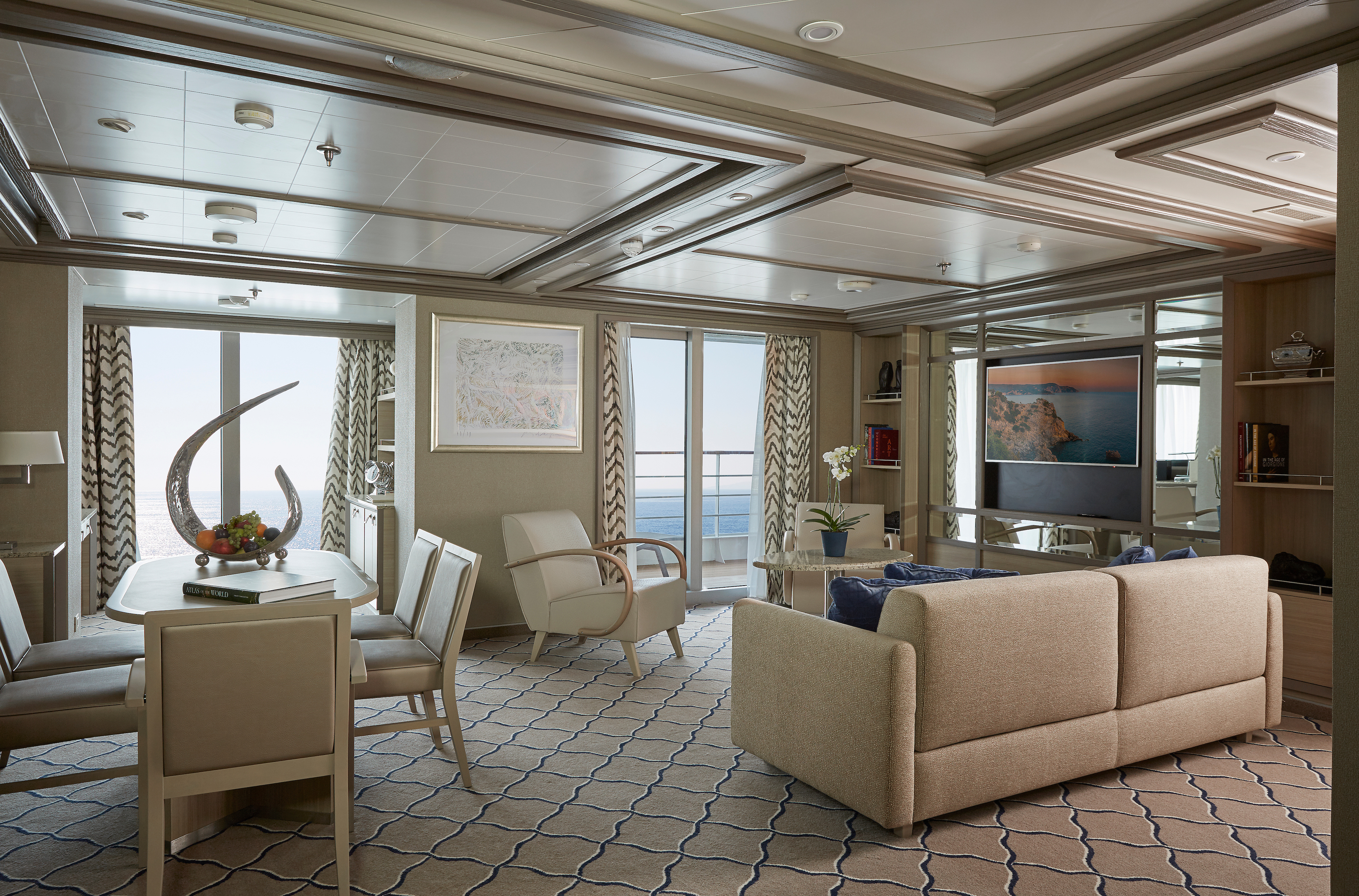
Available in a one or two bedroom configuration (so perfect for families) the Owner’s suite is the epitome of elegance at sea. A large seating area is the hub of the suite, equipped with all mod cons – think a Bose sound system, an interactive 55” TV and even an Illy coffee machine! Whether inside or relaxing on the large teak veranda, the Owner’s suite offers supreme comfort every hour of the day!
One bedroom: 88-98 sq.m. including veranda
Two bedroom: 119-129 sq.m. including veranda*
*The difference in size is largely due to a larger entry corridor space and does not concern the living or sleeping area.
Images are intended as a general reference. Features, materials, finishes and layout may be different than shown.
Please note that the 3rd guest will sleep on a comfortable sofa bed in the reception area of the suite.
Essentials
- Deck(s): 9
- Section: Mid-Ship
Characteristics
- Veranda
- Separate dining area
- Living room with sitting area
- Double vanity
- Separate shower
- Whirlpool bath
- Walk-in wardrobe with personal safe
Furniture
- King size bed
- Writing desk
- Vanity table
- Luxury bed mattresses
Media & Communication
- Unlimited Premium Wi-Fi
- 2 large flat screen TVs with Interactive Media Library
- Sound system with bluetooth connectivity
- Direct dial telephone
- Wall mounted USB-C mobile device chargers
- Dual voltage 110/220 outlets
Onboard Services
- Butler service
- Complimentary laundry, pressing & wet cleaning
- Daily canapé service, Welcome chocolate, Welcome fruit stand
- Dinner for two in La Dame, one evening per voyage,
- Two hours of worldwide phone use, per voyage segment
- Champagne on arrival
Amenities
- Espresso machine
- Pillow menu
- Refrigerator and bar setup stocked with your preferences
- Plush bathrobe
- Luxury bath amenities
- Umbrella
- Hair Dryer
- Slippers
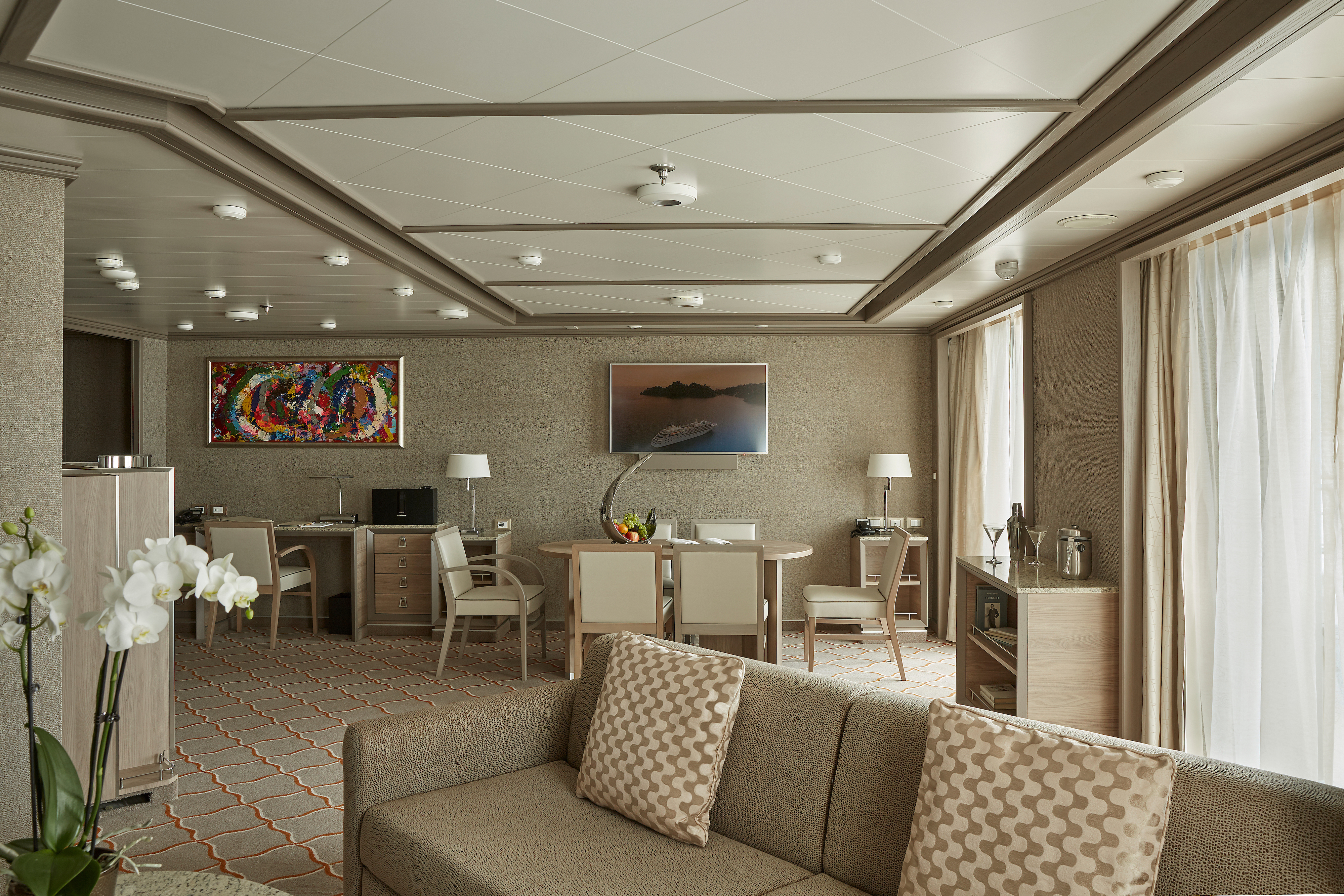
A grand traveller needs a grand suite, and we are happy to oblige! Get ready to scale new heights of comfort in our ultra-luxury Grand Suite. Situated at the front of the ship for the most spectacular views, the Grand Suite is for travellers who like the finer things in life. A large veranda, furnished with sunbeds, makes for perfect memories. Indoors, the sumptuous seating area and cosy bedrooms are the very definition of relaxing in style.
One bedroom: 137-146 sq.m. including veranda
Two bedroom: 174-183 sq.m. including veranda
Images are intended as a general reference. Features, materials, finishes and layout may be different than shown.
Please note that the 3rd guest will sleep on a comfortable sofa bed in the reception area of the suite.
Essentials
- Deck(s): 8, 9
- Section: Forward
Characteristics
- Veranda
- Separate dining area
- Living room with sitting area
- Double vanity
- Separate shower
- Whirlpool bath
- Walk-in wardrobe with personal safe
Furniture
- King size bed
- Writing desk
- Vanity table
- Luxury bed mattresses
Media & Communication
- Unlimited Premium Wi-Fi
- 2 large flat screen TVs with Interactive Media Library
- Sound system with bluetooth connectivity
- Direct dial telephone
- Wall mounted USB-C mobile device chargers
- Dual voltage 110/220 outlets
Onboard Services
- Butler service
- Complimentary laundry, pressing & wet cleaning
- Daily canape service, Welcome chocolate, Welcome fruit stand
- Dinner for two in La Dame, one evening per voyage,
- Two hours of worldwide phone use, per voyage segment
- Champagne on arrival
Amenities
- Espresso machine
- Pillow menu
- Refrigerator and bar setup stocked with your preferences
- Plush bathrobe
- Luxury bath amenities
- Umbrella
- Hair Dryer
- Slippers

With just two Royal Suites on board, this stateroom is in a class all of its own! Spacious and dignified, commanding and majestic, there’s no secret to why we named this suite Royal. Ample indoor space with a living room (including state of the art entertainment systems), twin beds that can be joined upon demand and even an adjoining bedroom if required, the Royal Suite is the answer when travelling with the family! Not to mention unlimited Wi-Fi, a sumptuous marble bathroom and spacious teak veranda, the Royal Suite is fit for a king!
One bedroom: 105 sq.m. including veranda
Two bedroom: 142 sq.m. including veranda
Images are intended as a general reference. Features, materials, finishes and layout may be different than shown.
Please note that the 3rd guest will sleep on a comfortable sofa bed in the reception area of the suite.
Essentials
- Deck(s): 7
- Section: Forward
Characteristics
- Veranda
- Separate dining area
- Living room with sitting area
- Double vanity
- Separate shower
- Whirlpool bath
- Walk-in wardrobe with personal safe
Furniture
- King size bed
- Writing desk
- Vanity table
- Luxury bed mattresses
Media & Communication
- Unlimited Premium Wi-Fi
- 2 large flat screen TVs with Interactive Media Library
- Sound system with bluetooth connectivity
- Direct dial telephone
- Wall mounted USB-C mobile device chargers
- Dual voltage 110/220 outlets
Onboard Services
- Butler service
- Complimentary laundry, pressing & wet cleaning
- Daily canape service, Welcome chocolate, Welcome fruit stand
- Dinner for two in La Dame, one evening per voyage,
- Two hours of worldwide phone use, per voyage segment
- Champagne on arrival
Amenities
- Espresso machine
- Pillow menu
- Refrigerator and bar setup stocked with your preferences
- Plush bathrobe
- Luxury bath amenities
- Umbrella
- Hair Dryer
- Slippers
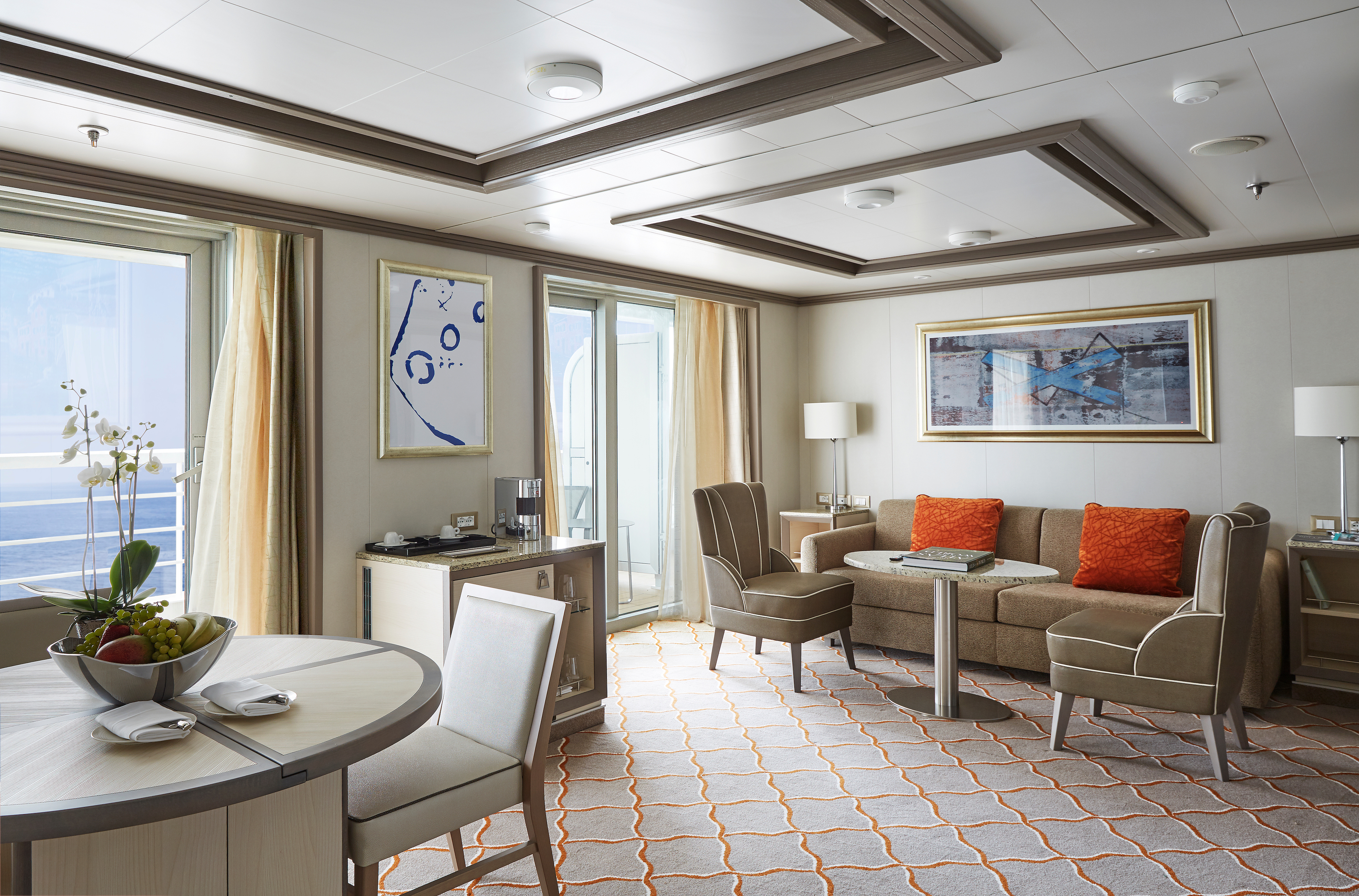
A Silversea favourite and by far our best-selling suite! The Silver Suite is one of the foundations of ultra-luxury cruising. Take travelling to a whole new level with the Silver Suite’s unparalleled levels of service, comfort and of course style! Available in either a one bedroom, a two bedroom or wheelchair accessible configuration, Silver Suites are fully equipped for the discerning traveller. Whether enjoying the spectacular views from the veranda or relaxing in the large sitting room, Silver Suites offer a comfortable haven on the high seas.
One bedroom: 73 sq.m. including veranda
Two bedroom: 104 sq.m. including veranda
Wheelchair accessible suite: 931
Images are intended as a general reference. Features, materials, finishes and layout may be different than shown.
Please note that the 3rd guest will sleep on a comfortable sofa bed in the reception area of the suite.
Essentials
- Deck(s): 9, 10, 11
- Section: Forward, Mid-Ship
Characteristics
- Veranda
- Living room with sitting area
- Double vanity
- Separate shower
- Whirlpool bath
- Walk-in wardrobe with personal safe
Furniture
- King size bed
- Writing desk
- Vanity table
- Luxury bed mattresses
Media & Communication
- Unlimited Premium Wi-Fi
- 2 large flat screen TVs with Interactive Media Library
- Sound system with bluetooth connectivity
- Direct dial telephone
- Wall mounted USB-C mobile device chargers
- Dual voltage 110/220 outlets
Onboard Services
- Butler service
- Complimentary laundry, pressing & wet cleaning
- Daily canape service, Welcome chocolate, Welcome fruit stand
- Champagne on arrival
Amenities
- Espresso machine
- Pillow menu
- Refrigerator and bar setup stocked with your preferences
- Plush bathrobe
- Luxury bath amenities
- Umbrella
- Hair Dryer
- Slippers
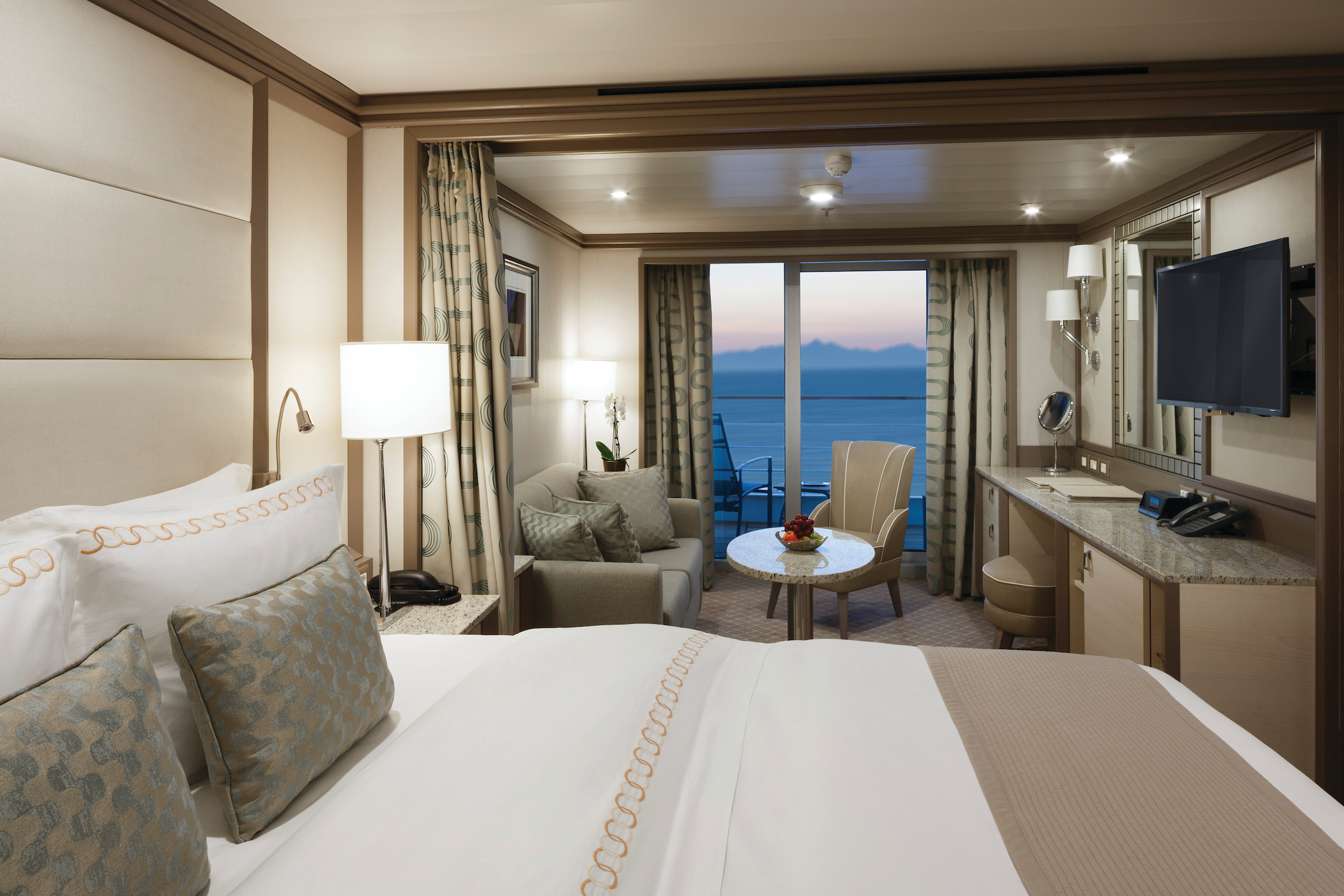
After a busy day of on shore exploring, the Deluxe Veranda Suite is the perfect home away from home. Spacious and well-situated, enjoy ultra-luxury amenities from the 24-hour butler service to the well-stocked mini-bar (and yes, they’re all included!). Not forgetting the teak veranda from which the suite takes her name, the Deluxe Veranda is the perfect setting for making perfect memories.
One bedroom: 36 sq.m. including veranda
Images are intended as a general reference. Features, materials, finishes and layout may be different than shown.
Please note that the 3rd guest will sleep on a comfortable sofa bed in the reception area of the suite.
Essentials
- Deck(s): 6, 7, 8
- Section: Mid-Ship
Characteristics
- Veranda
- Sitting area
- Standard vanity
- Separate shower
- Full-size bath
- Walk-in wardrobe with personal safe
Furniture
- Queen size bed
- Writing desk
- Luxury bed mattresses
- Media & Communication
- Unlimited Standard Wi-Fi
- 1 large flat screen TV with Interactive Media Library
- Direct dial telephone
- Wall mounted USB-C mobile device chargers
- Dual voltage 110/220 outlets
Onboard Services
- Butler service
- Champagne on arrival
Amenities
- Pillow menu
- Refrigerator and bar setup stocked with your preferences
- Plush bathrobe
- Luxury bath amenities
- Umbrella
- Hair Dryer
- Slippers

A superior location makes the Superior Veranda Suite, well … superior! From the sumptuous views from the teak veranda to the spacious sitting room and large marble bathroom, everything about the Superior Veranda has been designed for your comfort. So settle in and get comfortable, order some 24-hours room service from your butler and enjoy a bit of R&R. We guarantee you won’t want to leave.
One bedroom: 36 sq.m. including veranda
Images are intended as a general reference. Features, materials, finishes and layout may be different than shown.
Please note that the 3rd guest will sleep on a comfortable sofa bed in the reception area of the suite.
Essentials
- Deck(s): 7, 8, 9
- Section: Forward
Characteristics
- Veranda
- Sitting area
- Standard vanity
- Separate shower
- Full-size bath
- Walk-in wardrobe with personal safe
Furniture
- Queen size bed
- Writing desk
- Luxury bed mattresses
Media & Communication
- Unlimited Standard Wi-Fi
- 1 large flat screen TV with Interactive Media Library
- Direct dial telephone
- Wall mounted USB-C mobile device chargers
- Dual voltage 110/220 outlets
Onboard Services
- Butler service
- Champagne on arrival
Amenities
- Pillow menu
- Refrigerator and bar setup stocked with your preferences
- Plush bathrobe
- Luxury bath amenities
- Umbrella
- Hair Dryer
- Slippers
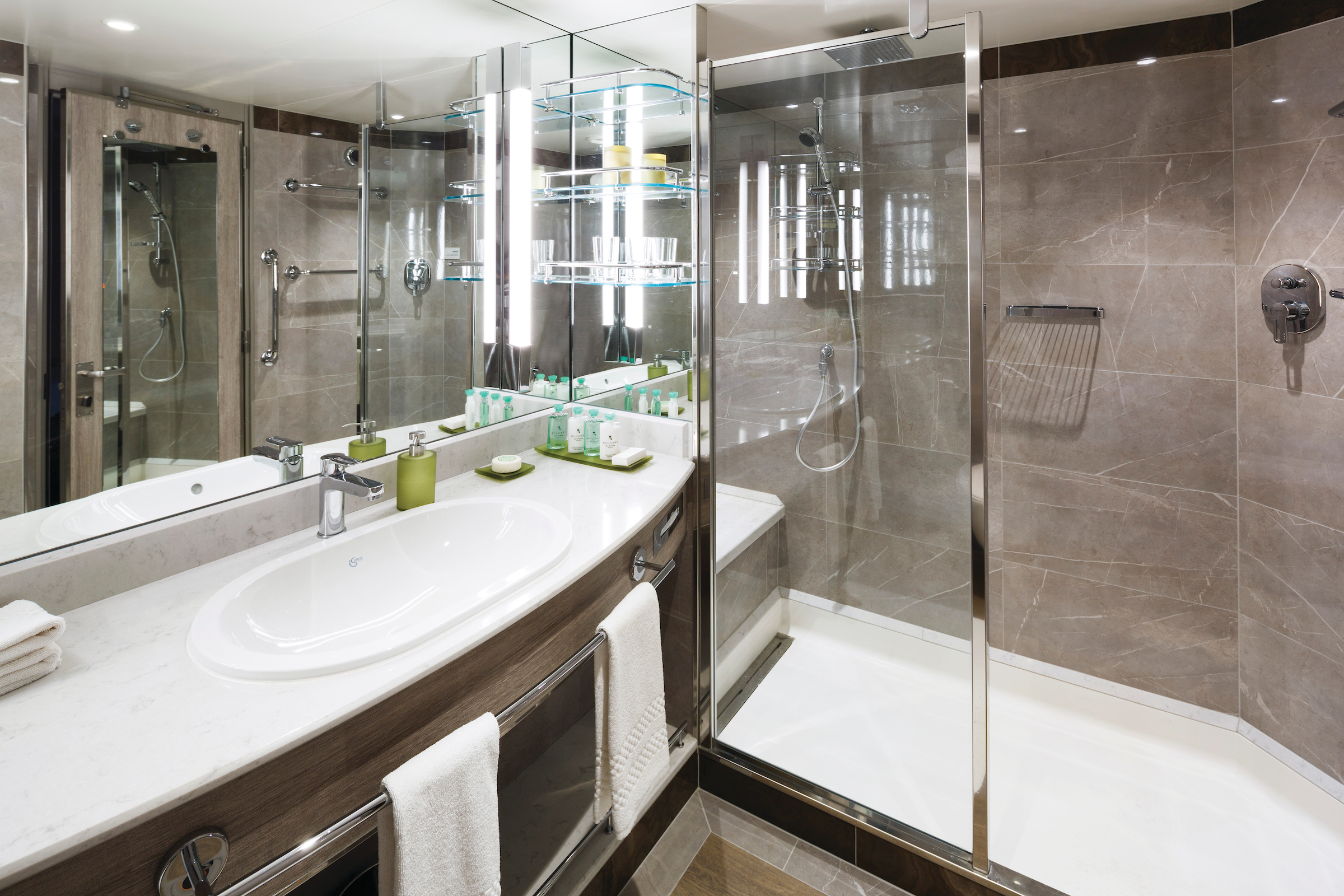
A lower-bow location makes the Classic Veranda Suite a comfortable choice for travellers. A lovely comfortable bed – available in a twin or queen bed configuration – with a choice of mattress makes sure that you enjoy the best night’s sleep of your life, while the seating area is perfect for in-suite dining. But perhaps the Classic Veranda’s best feature lies outside the suite – with the 6m2 veranda for which the suite was named.
One bedroom: 36 sq.m. including veranda
Images are intended as a general reference. Features, materials, finishes and layout may be different than shown.
Essentials
- Deck(s): 5, 6
- Section: Forward
Characteristics
- Veranda
- Sitting area
- Standard vanity
- Separate shower
- Full-size bath
- Walk-in wardrobe with personal safe
Furniture
- Queen size bed
- Writing desk
- Luxury bed mattresses
Media & Communication
- Unlimited Standard Wi-Fi
- 1 large flat screen TV with Interactive Media Library
- Direct dial telephone
- Wall mounted USB-C mobile device chargers
- Dual voltage 110/220 outlets
Onboard Services
- Butler service
- Champagne on arrival
Amenities
- Pillow menu
- Refrigerator and bar setup stocked with your preferences
- Plush bathrobe
- Luxury bath amenities
- Umbrella
- Hair Dryer
- Slippers

Beautiful elegant furnishings are the perfect choice to soothe and relax as you sail from one destination to the next. Large windows flood the room with light, making for luxurious sea views whether it’s morning, noon or night! Panorama suites are the perfect accompaniment to a Silver Suite for larger parties, or just perfect on their own. With all the mod cons that you would expect from an ultra-luxury cruise line, Panorama Suites offer comfort, space and style!
One bedroom: 31 sq.m.
Images are intended as a general reference. Features, materials, finishes and layout may be different than shown.
Essentials
- Deck(s): 9
- Section: Forward
Characteristics
- Floor-to ceiling window
- Sitting area
- Standard vanity
- Separate shower
- Full-size bath
- Walk-in wardrobe with personal safe
Furniture
- Queen size bed
- Writing desk
- Luxury bed mattresses
Media & Communication
- Unlimited Standard Wi-Fi
- 1 large flat screen TV with Interactive Media Library
- Direct dial telephone
- Wall mounted USB-C mobile device chargers
- Dual voltage 110/220 outlets
Onboard Services
- Butler service
- Champagne on arrival
Amenities
- Pillow menu
- Refrigerator and bar setup stocked with your preferences
- Plush bathrobe
- Luxury bath amenities
- Umbrella
- Hair Dryer
- Slippers

Comfortable, spacious and offering stupendous ocean views, the Vista Suite carries its name very well! Wake up to wide ocean views, breakfast to the sound of the waves lapping at the side of the ship or simply relax with the in-suite entertainment system and comfy sofas. Some Vista Suites are a little larger than standard – perfect for our guests with limited mobility. If you have ever wanted a home away from home on the high seas, the vista Suite is it.
One bedroom: 32 sq.m.
Wheelchair accessible suites: 407, 409, 417
Images are intended as a general reference. Features, materials, finishes and layout may be different than shown.
Essentials
- Deck(s): 4
- Section: Forward
Characteristics
- Window
- Sitting area
- Standard vanity
- Separate shower
- Full-size bath
- Walk-in wardrobe with personal safe
Furniture
- Queen size bed
- Writing desk
- Luxury bed mattresses
Media & Communication
- Unlimited Standard Wi-Fi
- 1 large flat screen TV with Interactive Media Library
- Direct dial telephone
- Wall mounted USB-C mobile device chargers
- Dual voltage 110/220 outlets
Onboard Services
- Butler service
- Champagne on arrival
Amenities
- Pillow menu
- Refrigerator and bar setup stocked with your preferences
- Plush bathrobe
- Luxury bath amenities
- Umbrella
- Hair Dryer
- Slippers

Take your travel experience further than ever before in the S.A.L.T. Kitchen. Silver Dawn’s exclusive destination focused restaurant is the place to be when it comes to enjoying the local cuisine, culture and rich culinary heritage of your voyage. Taste your way through regional specialities for your most immersive travel experience ever. Whether you are looking for excellent food and wine, a social meal with friends or a deeper understanding of your region’s culture, expect to find it in the S.A.L.T. Kitchen.
Images are intended as a general reference. Features, materials, finishes and layout may be different than shown.

Silversea’s signature French restaurant, La Dame is the epitome of fine dining. Featuring the rich, smooth flavours of France, La Dame’s reputation for gastronomic excellence is fully upheld aboard Silver Dawn. Expect only the very best; chic contemporary style, vast ocean-view windows, crisp white table linens and impeccable white-gloved silver service with a smile. Decorated with custom-made interior panel compositions created by Lalique, there is no better place to feel the culinary soul of France than in La Dame.
Per guest reservation fee of US$60.
Images are intended as a general reference. Features, materials, finishes and layout may be different than shown.
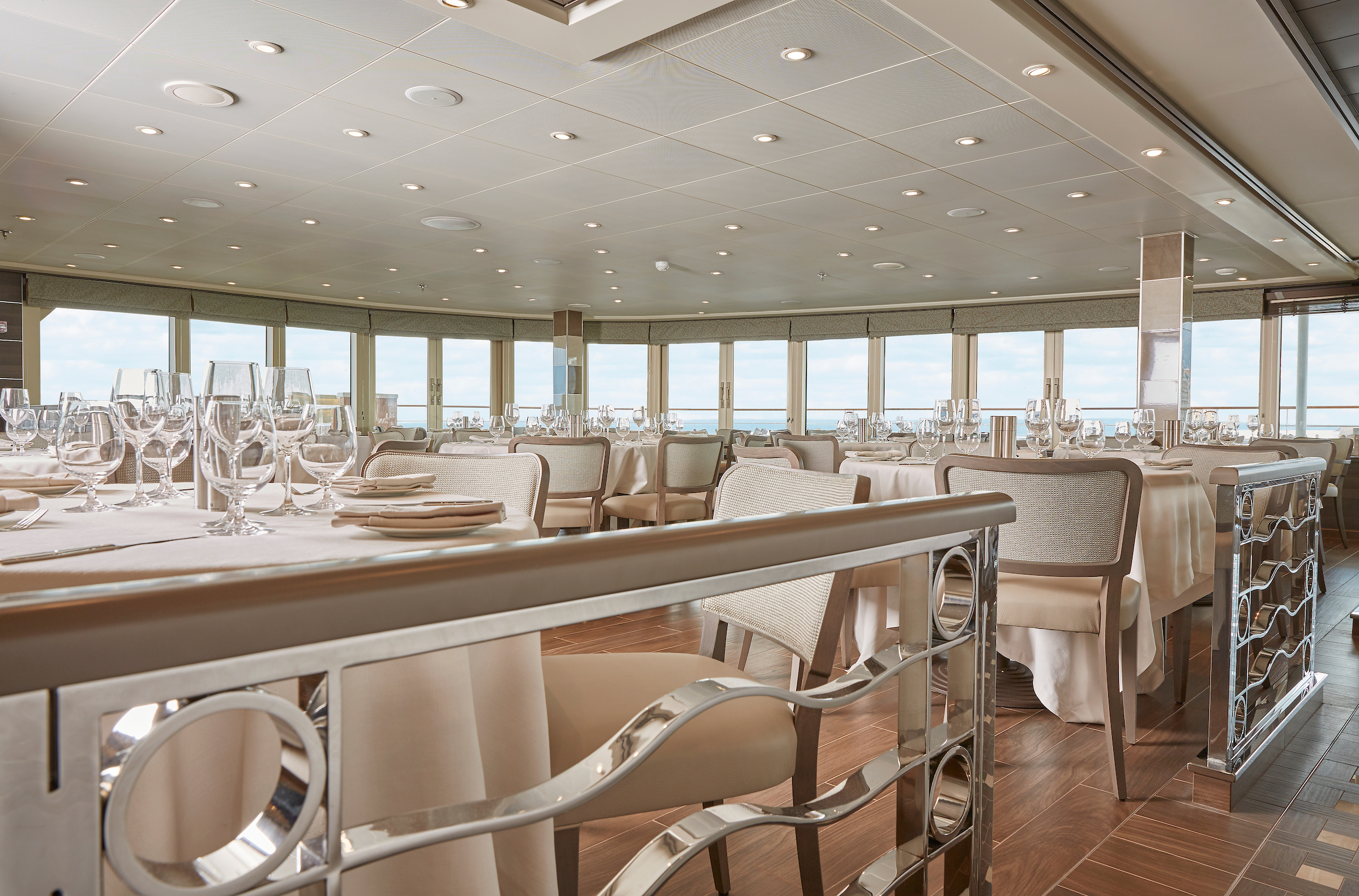
An iconic hallmark of Silversea dining, La Terrazza offers authentic recipes and the freshest ingredients from our distinctive Italian heritage. This is where antipasti, primi and secondi come together with passion and flair in a flavourful expression from corporate chef Alberto Colombo’s imagination. La Terrazza aboard Silver Dawn offers innovative interactive food stations: an olive oil cellar, a mozzarella bar, a seafood station and of course a salumeria. The à la carte menu has also been extended to include the popular Sapori di Casa, traditional family-style Italian daily specials.
Images are intended as a general reference. Features, materials, finishes and layout may be different than shown.
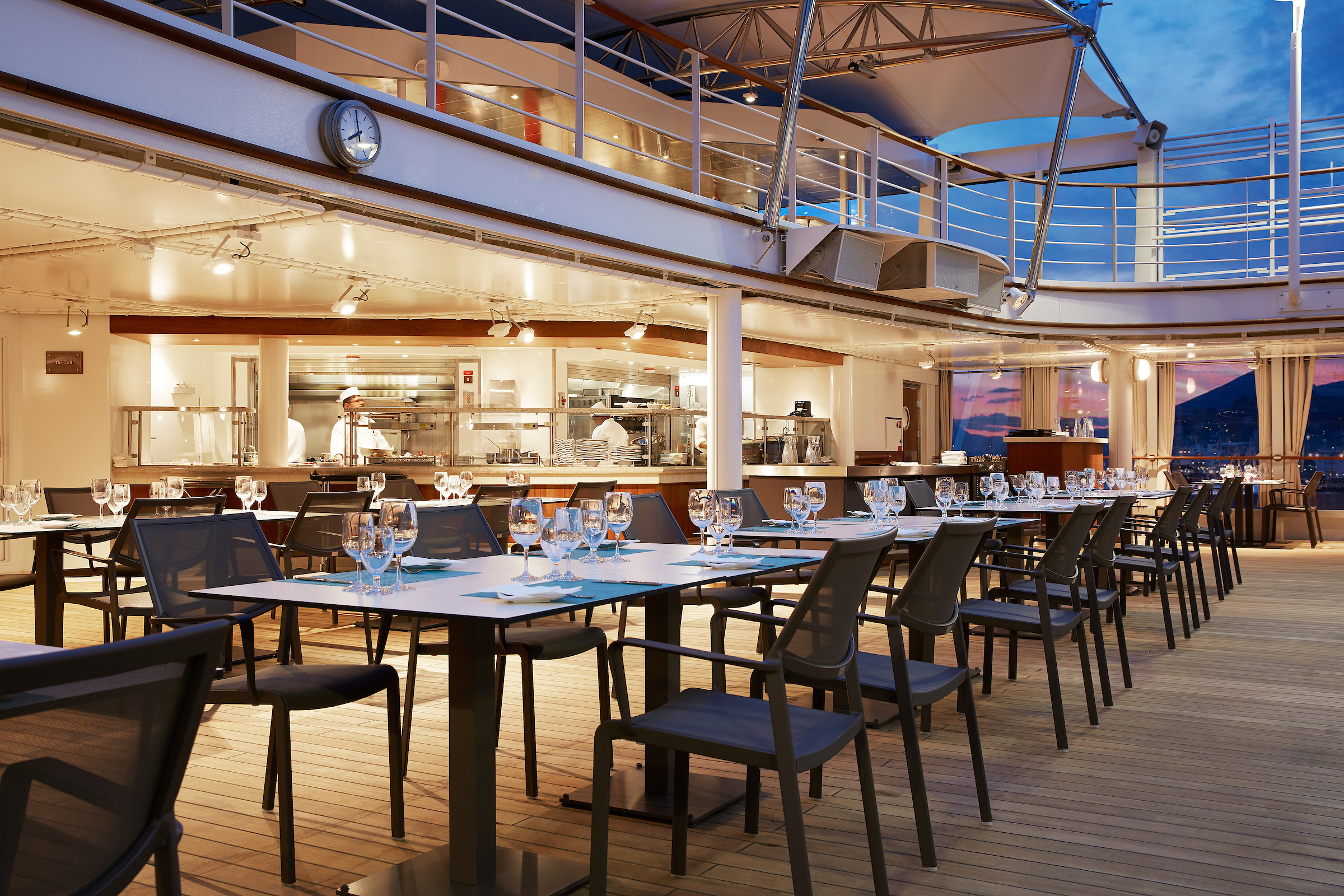
One of the healthiest cuisines to exist, The Grill features lava stone cooking at its finest. Sourced from volcanic rock and placed in an oven to reach an optimum temperature of 400˚C, The Grill invites guests to cook their food directly at their table. Place your meat, fish or vegetables on top of the grill stone or inside the soup bowl, and then simply cook to your very own taste. Every bite is cooked to perfection, time after time. With the stone cooking available in the evenings only, The Grill becomes a daytime rotisserie and gourmet salad and burger bar, offering build your own burgers from the best selections of meat.
Images are intended as a general reference. Features, materials, finishes and layout may be different than shown.
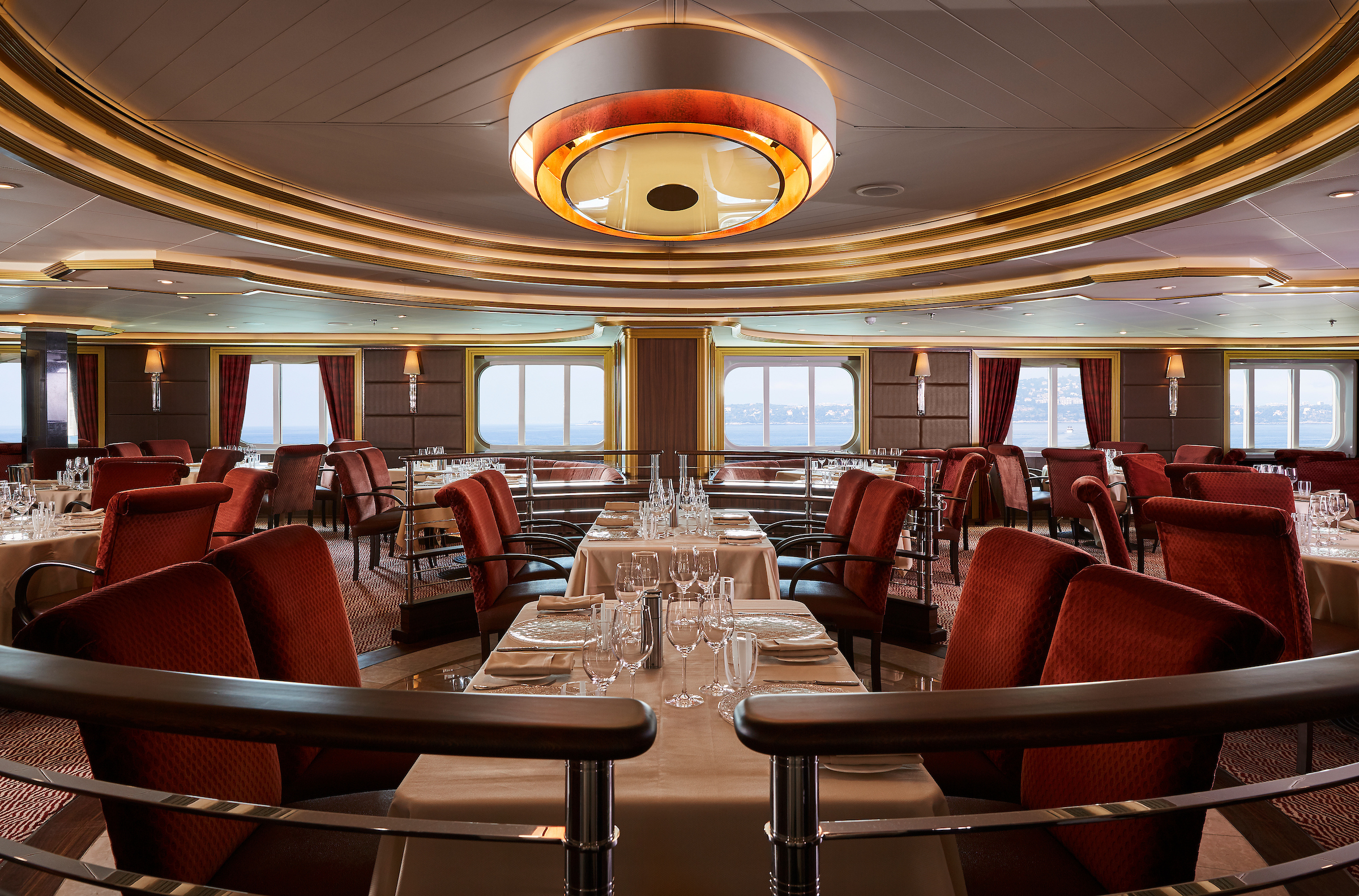
Instantly recalling images of the sea in all her watery majesty, the Atlantides are the seven nymph daughters of Atlas. Creative muses, known for their wisdom and beauty, the sisters were granted immortality in the form of stars and can be seen today in the constellation of Taurus. Pivotal to Silver Moon dining experience, this elegant bar and grill incorporates the best that the sea has to offer. Created to temper your taste buds, designer dishes such as royal crab, blue lobster and Verbena infused red snapper in a sea salt crust are showcased alongside the best steaks offshore.
Images are intended as a general reference. Features, materials, finishes and layout may be different than shown.

The fine art of Kaiseki lies in its meticulous preparation and beautiful presentation. Dishes reflect a passion for tradition and performance and our reinterpretation of these values is clear. Balanced menus have been inspired by the five elements of Japanese nutritional cuisine and respect the equilibrium of yin and yang. Daytime menus feature a varied and balanced menu of sushi, sashimi and other raw Asian-inspired dishes, while the evenings are alive with the taste and traditions of fine Japanese dining.
Per guest reservation fee of US$40.
Images are intended as a general reference. Features, materials, finishes and layout may be different than shown.
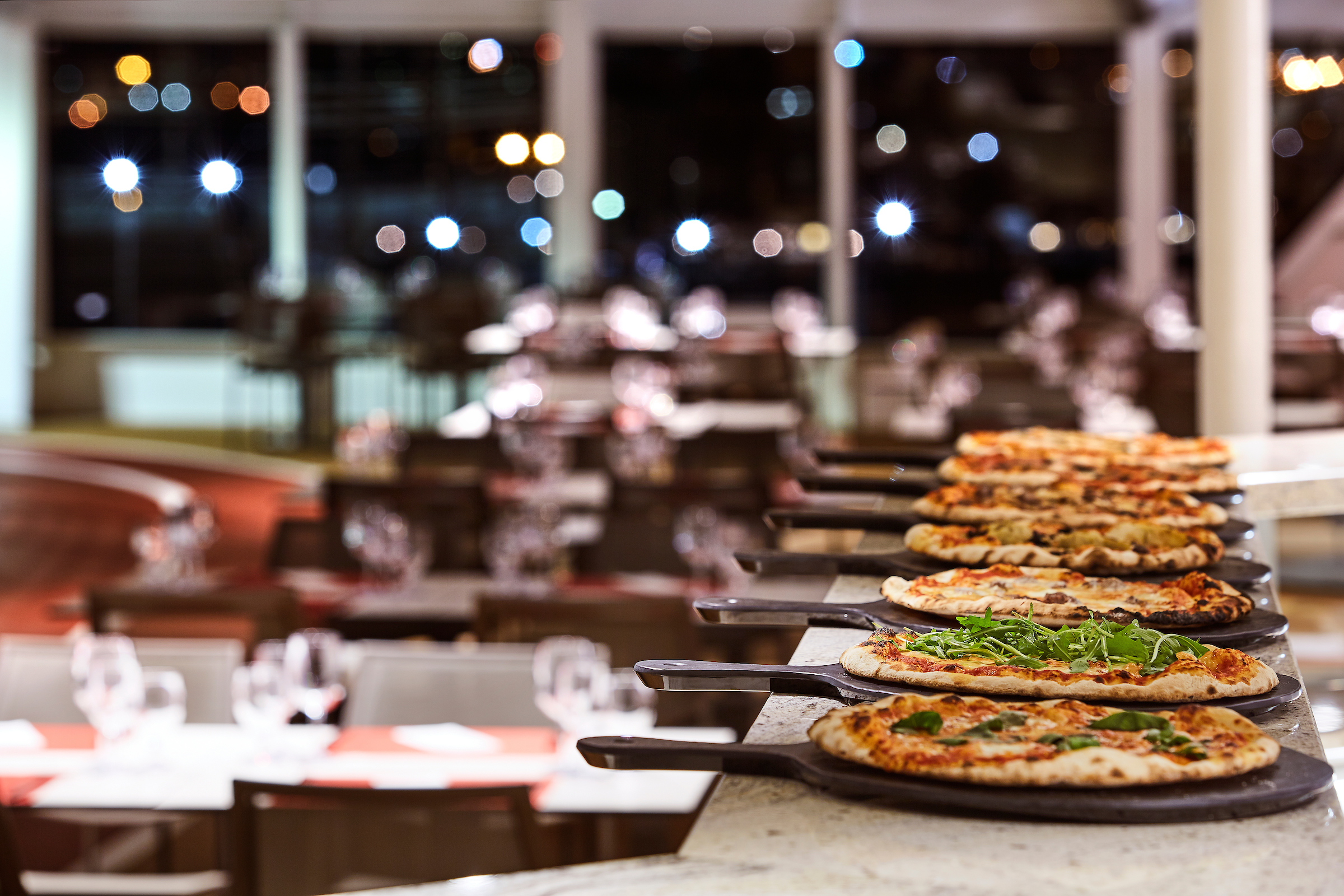
Reflecting Silversea’s Italian heritage, this emblematic street in Naples divides the city in two and is renowned for its pizzerias. No visit to the city is complete without a journey to Spaccanapoli. Therefore it is unsurprising that Spaccanapoli aboard Silver Dawn reflects the true Italian way of life: the freshest ingredients, authentic dough and a perfect sense of the fabled Italian lust for life. The simplicity of la dolce vita is reflected in the relaxed dining style of the restaurant.
Images are intended as a general reference. Features, materials, finishes and layout may be different than shown.
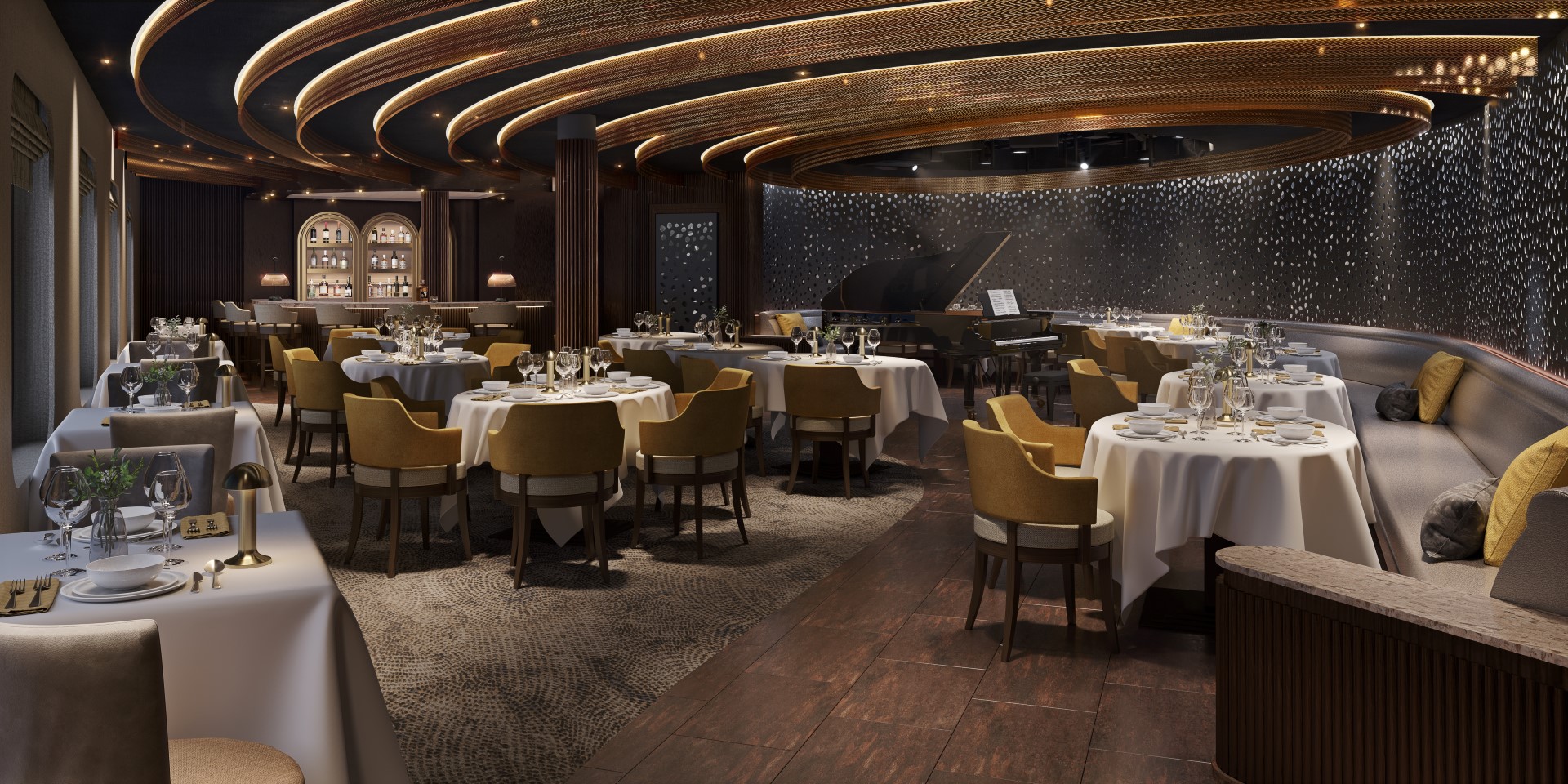
A sumptuous, intimate setting with a lively, joie de vivre ambience is the perfect place to dine, dance and dream the night away… Small plate tapas-style dishes of mouth-watering international cuisine perfectly compliment the rich, exciting entertainment as the smooth sounds of jazz and blues gently caress your ears. A refined late evening menu perfectly showcases the panache and style of Silver Dawn’s plentiful dining options, so expect multisensory fireworks as you swing and sway effortlessly across the dance floor as Silver Dawn gracefully takes you to your next destination.
Images are intended as a general reference. Features, materials, finishes and layout may be different than shown.
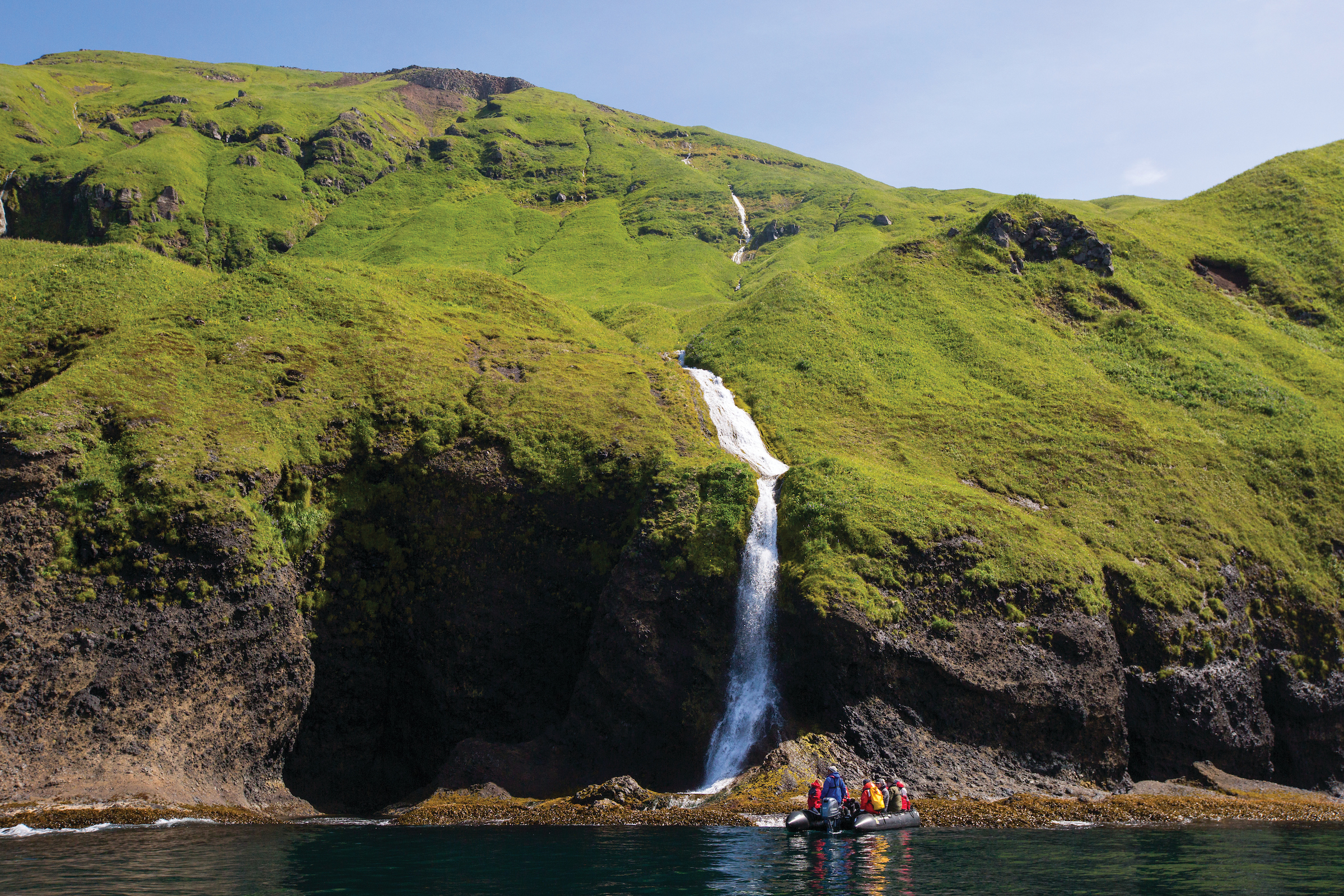
Silversea’s experienced Shore Concierge team are happy to assist, ensuring your shore- side experience is nothing less than a memory that lasts forever. Their knowledge and understanding of ports will truly add to your enjoyment and experience. Detailing history, local flavour, culture, regional customs, shopping tips and much more, they will make sure you get the best of your destination, wherever you are in the world.

Multiple days at sea mean plenty of R & R for some, but others prefer to drink in all there is to offer on land. Our Mid-Cruise Land Adventures allow you to take full advantage of your time with us without missing a single thing! These short escapades offer an array of adventures, break up your sea days and allow for deeper exploration beyond the coast.

Let Silversea customise a special event or excursion exclusively for you. Expert Shore Excursion professionals are available to assist with all your shorex questions. Make an appointment and gain insider access to knowledgeable suggestions, personalised planning and hassle-free coordination of all private, independent touring, including area highlights, flightseeing, water sports, and much more. Take advantage of this service either in advance of your voyage by email at shoreconcierge@silversea.com or on board by visiting the Silvershore® Concierge desk. Have the Silver Shore Concierge create your tailor-made tour, or be whisked away by private car for a day — the pace and agenda are up to you.
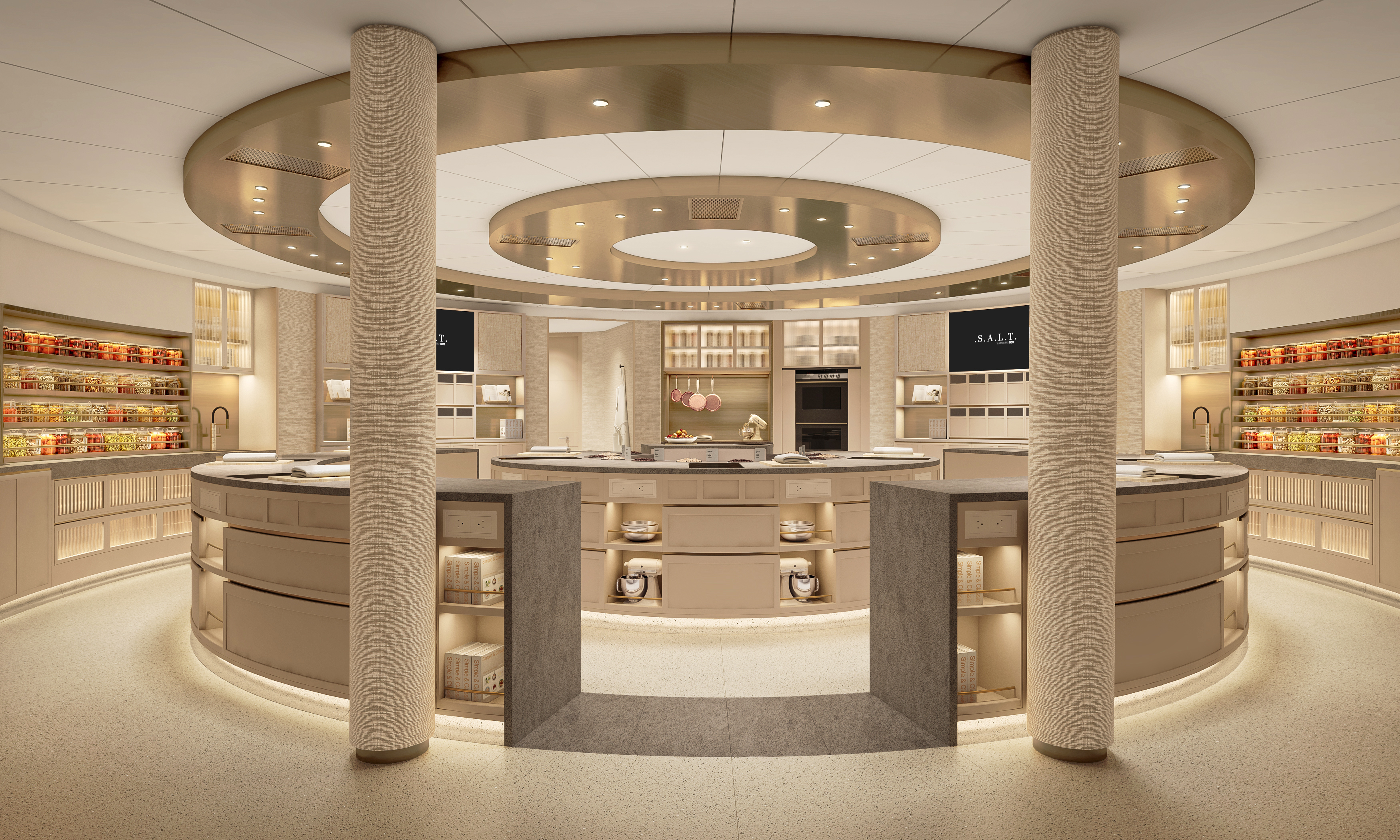
Welcome to the S.A.L.T. Lab, an interactive space where guests can deep-dive into local culinary heritage and techniques. Join our talented chefs and learn how your region’s food is central to its culture. Engage in your destination through workshops, lectures and cooking demonstrations for an authentic souvenir not available in any shop. The S.A.L.T. Lab is not just about food and flavour; it is a unique place where holistic destination immersion gives an entirely new dimension to travelling. This is where the magic happens!
Images are intended as a general reference. Features, materials, finishes and layout may be different than shown.

Selected shore excursions on all Silver Moon, Silver Dawn and Silver Nova cruises benefit from a culinary focus. These in-depth and informative shore excursions are accompanied by our food experts, who are adept at explaining the intricacies of foreign cuisine. S.A.L.T. offers the curious cruiser so many options; the only thing you need to do is choose. Never has a cruise line provided such an in-depth, holistic way of visiting their destination. Do one or do them all.
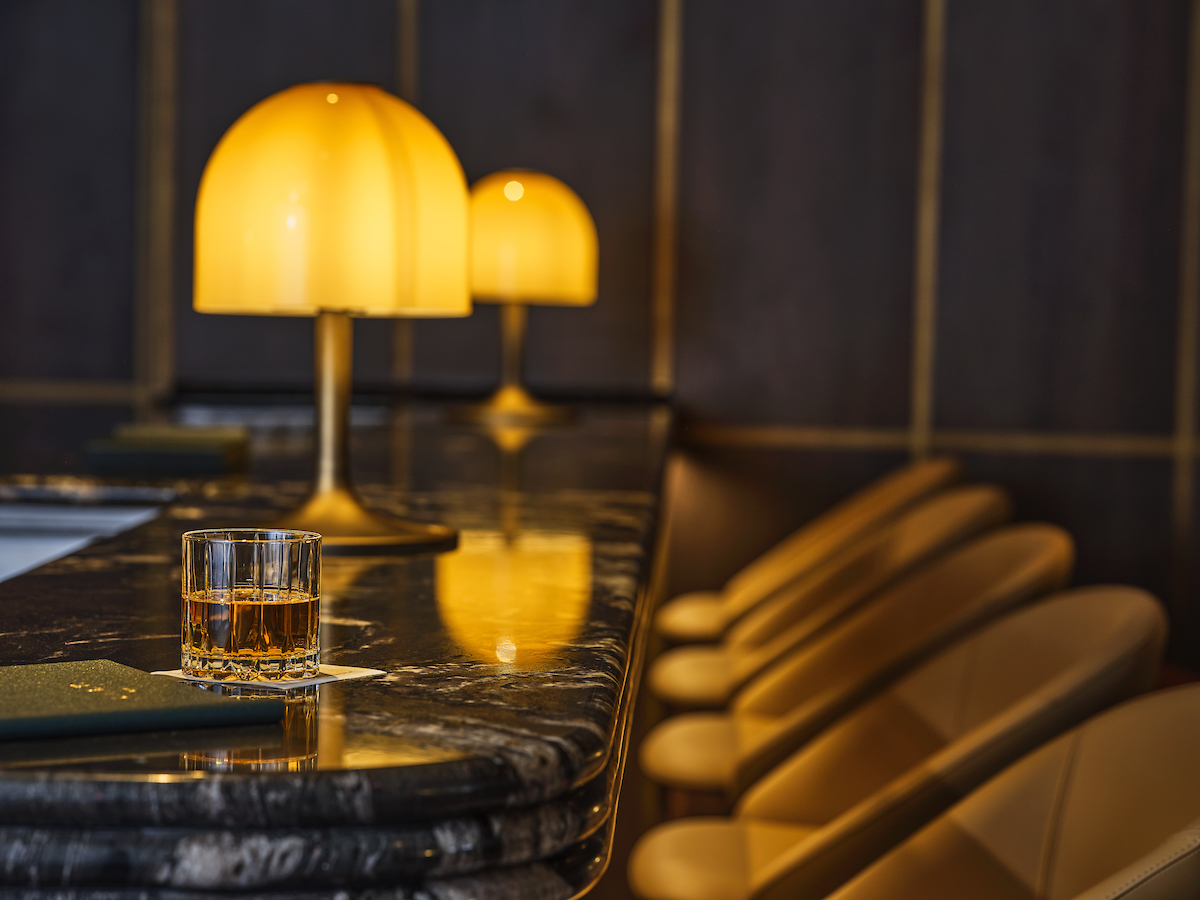
Nothing says authentic experience better than Silver Dawn’s S.A.L.T. Bar. Get a taste for the authentic and settle down to enjoy locally-inspired cocktails and drinks. How can you go wrong with a Rum Punch in Barbados, a Pastis over ice in Marseille or a Pisco Sour in Lima? Nothing unites new faces and old friends in quite the same way. Be inspired to find your perfect locally-inspired beverage at the S.A.L.T. Bar and let in the colour and flavours of your journey rush in.
Images are intended as a general reference. Features, materials, finishes and layout may be different than shown.
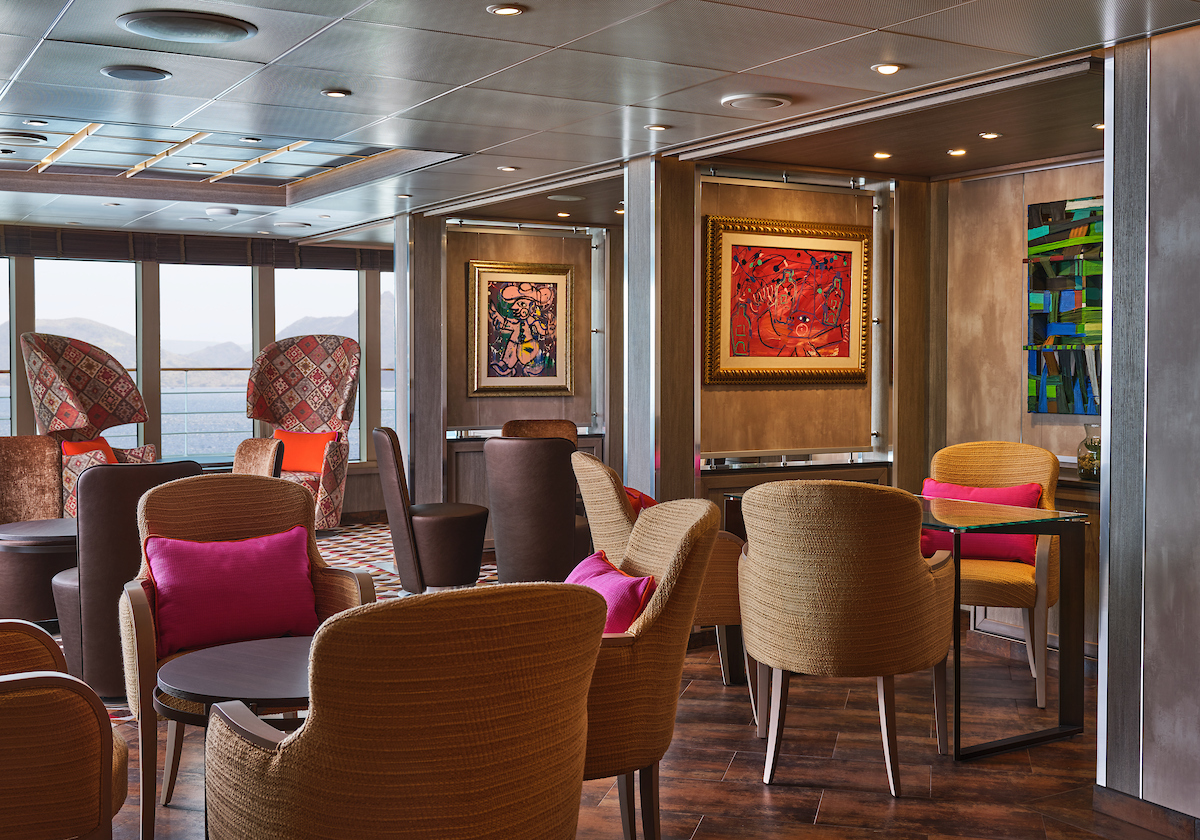
Nestled cosily on deck 8 is the all-new Arts Café. Hosting varied and exciting exhibitions, the Arts Café will showcase paintings and sculptures from a broad range of talent. The distinctive design of the venue is a relaxing getaway and offers daytime cuisine in the form of a café and deli-bar. But come early evening, the venue turns into a lively, evening cocktail lounge meaning you can retreat to one of the comfortable chairs, grab a drink and relax as you absorb the incredible view and watch the world float by. Whether you prefer the gentle sea breeze of the terrace or the sophistication of the inside, a superlative experience is always assured.
Images are intended as a general reference. Features, materials, finishes and layout may be different than shown.
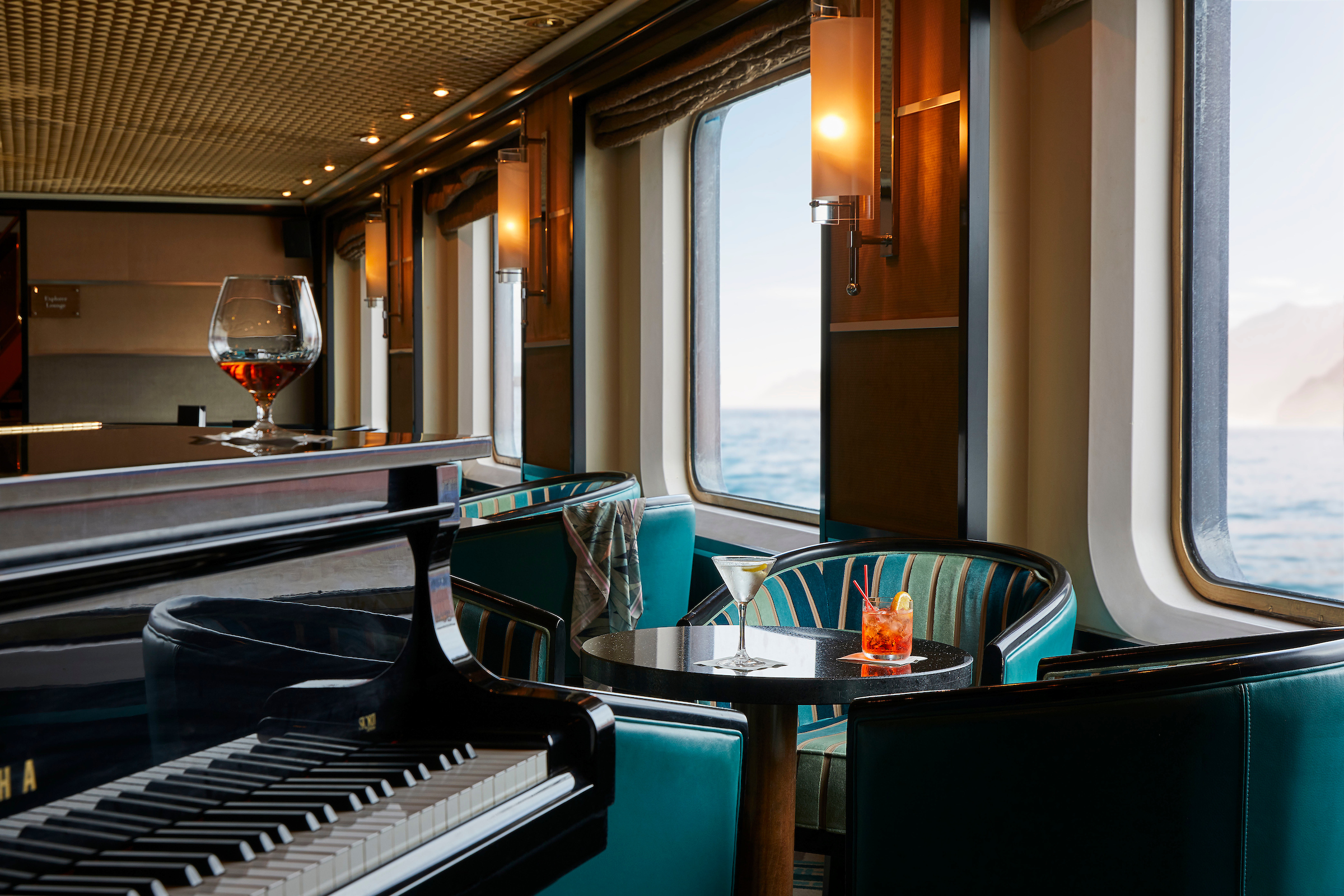
Our main bar has been newly reimagined for Silver Dawn! Dolce Vita has of course kept her legendary charm, inspired cocktails, stylish décor and comfortable seating, but a central bar now means the warm ambience is better than ever! Oozing Italian glamour, Dolce Vita is a relaxed, refined bar with a nightly piano player playing all your favourite tunes. Perfect for pre-dinner aperitivi, or even a post-dinner cocktail, Dolce Vita is truly the beating heart of social life on board.
Images are intended as a general reference. Features, materials, finishes and layout may be different than shown.
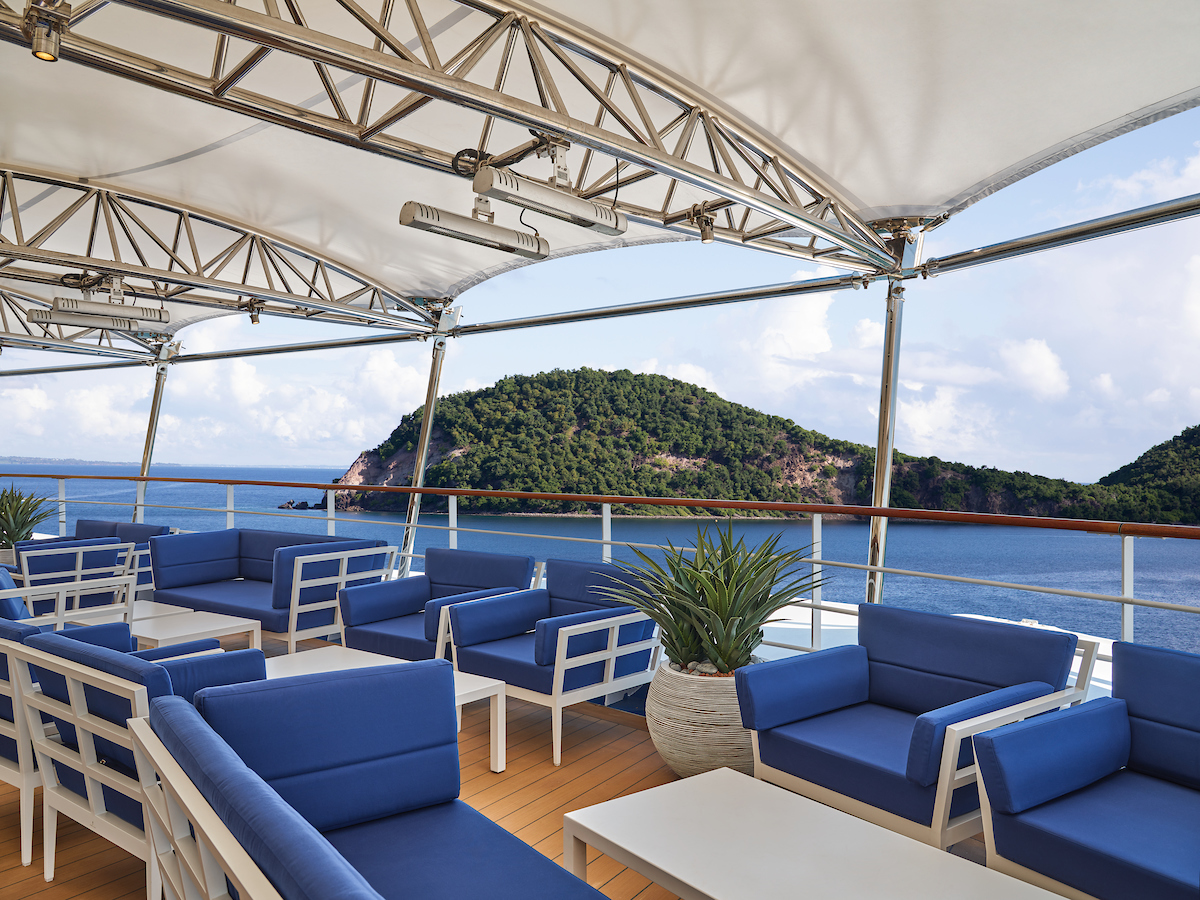
From early morning to late at night, the Panorama lounge offers everything you could wish for. A peaceful retreat that is the perfect place to break away to, a social place to meet and greet old friends, or an evening venue to partake in a cocktail as you sit back and watch the world go by. Sink into the plush seats and come evening, enjoy listening to the gentle sounds of a pianist, or the invigorating beats of our in-house DJ.
Images are intended as a general reference. Features, materials, finishes and layout may be different than shown.
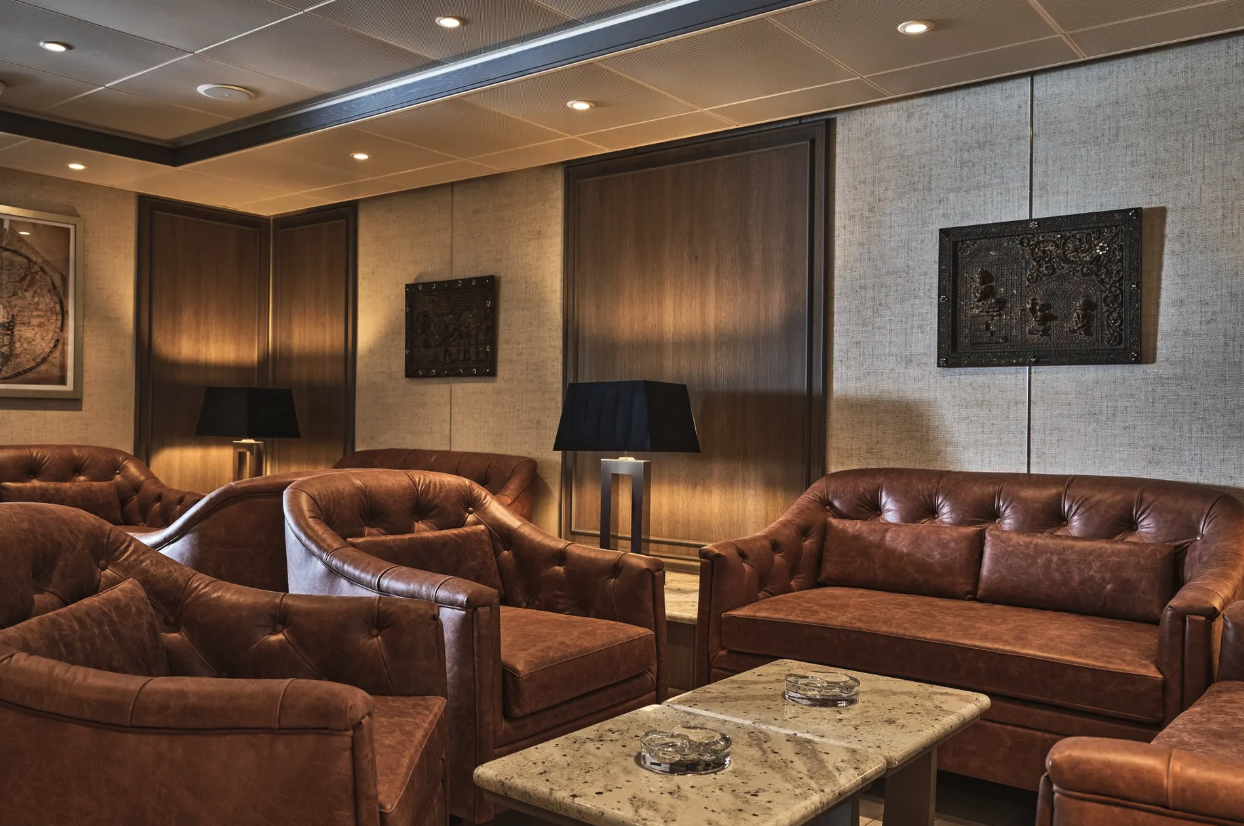
Our smoking lounge aboard Silver Dawn is our latest venue where cigar-lovers can buy and sample some of the world’s finest Havanas, Cohibas, Partagás, Montecristos, Ramón Allones and Bolívars. Combining all the elements of cigar culture both indoors and on its stylish terrace, the Connoisseur’s Corner is where aficionados can meet and mingle to share their iconic passion.
Images are intended as a general reference. Features, materials, finishes and layout may be different than shown.
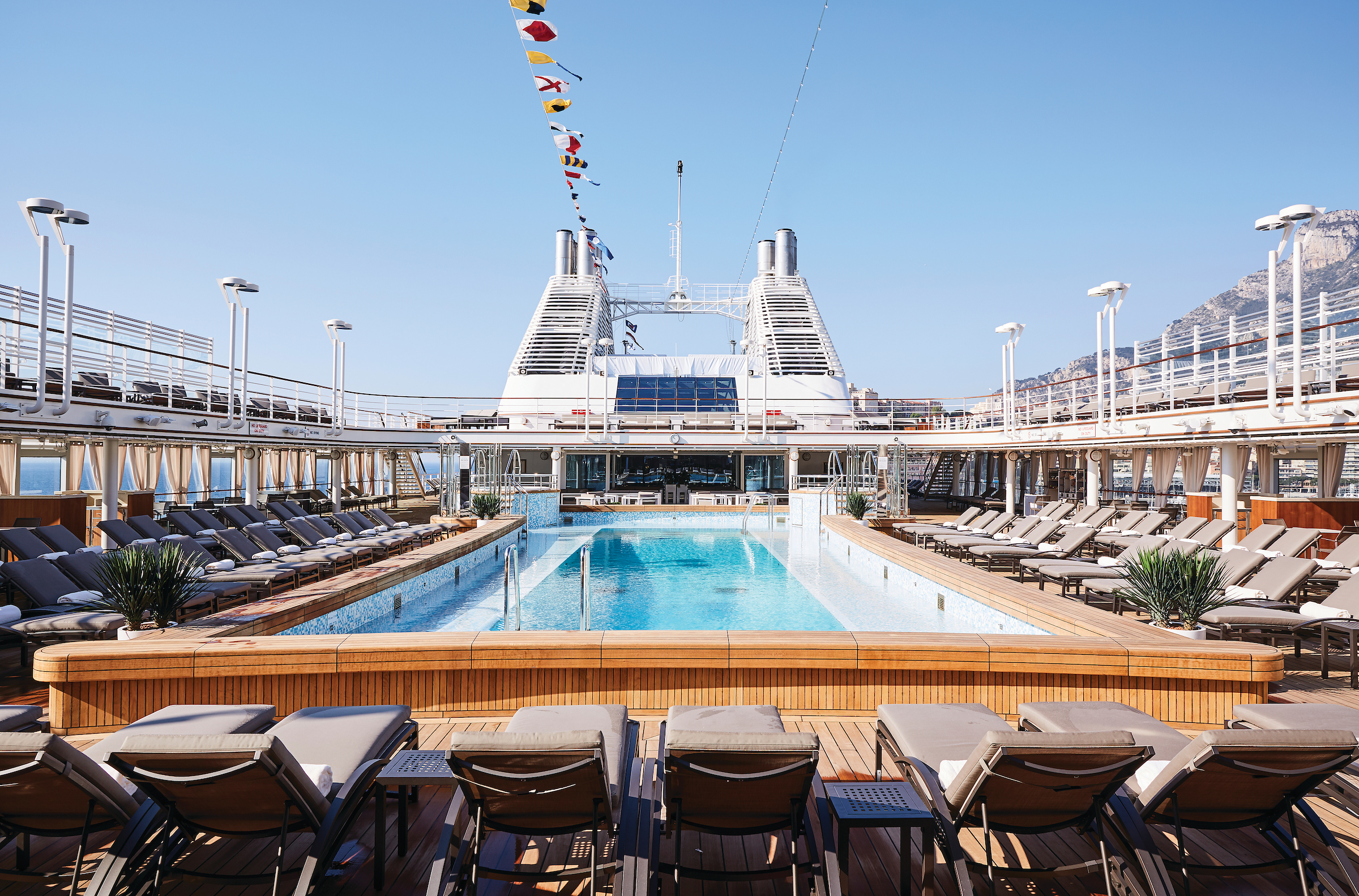
The epitome of open air living — defining how you enjoy the outdoors, this is the place to cool off, unwind and enjoy the sunshine. Take a dip in the pool, relax in one of the whirlpools or simply soak up the view from one of the sunbeds, while your pool attendant anticipates your every whim. A little more ice? Certainly. A plush towel to dry off with? Of course. With breathtaking landmarks gliding by, dive into the clear waters in a setting that is so idyllic that you will not want to disembark.
Images are intended as a general reference. Features, materials, finishes and layout may be different than shown.

Set on the highest level at the very top of the ship, this is a quiet space for reading and reflection while being dazzled by the undulating seascapes that are constituent to life on board. Borrow a book from the in-house library, read the papers or just embrace the tranquillity of being at sea.
Images are intended as a general reference. Features, materials, finishes and layout may be different than shown.
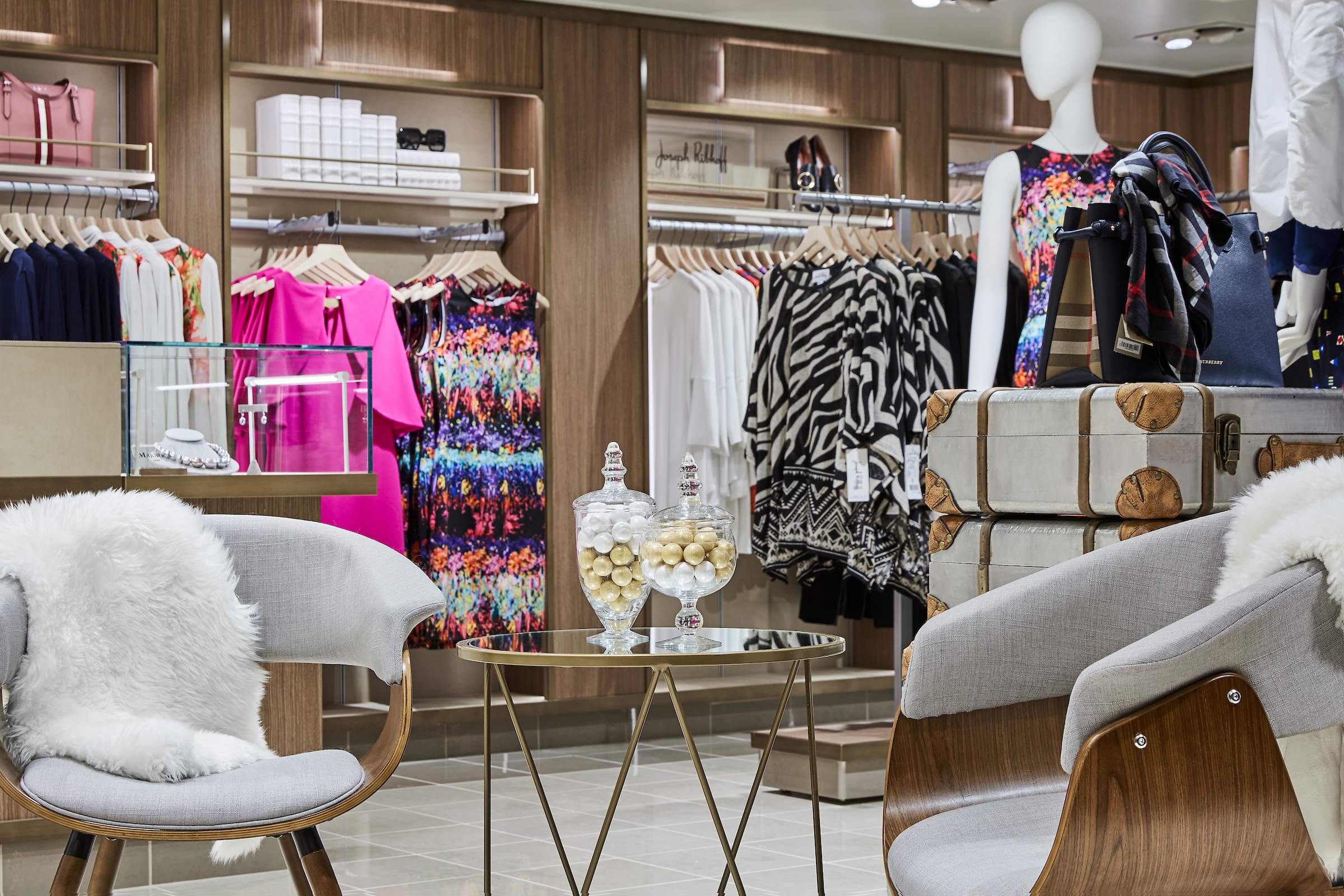
Exceptional shopping experiences do not end in the cosmopolitan cities we visit. Silversea’s striking new shipboard boutiques, reimagined and redesigned are stunning modern design spaces befitting the finest creations from legendary designers. Carefully selected partners onboard Silversea’s duty-free boutiques offers our guests a carefully curated selection of cutting edge fashions, jewelry, accessories, fine perfumes, cosmetics and Silversea Logo collection all at duty-free prices.
Images are intended as a general reference. Features, materials, finishes and layout may be different than shown.
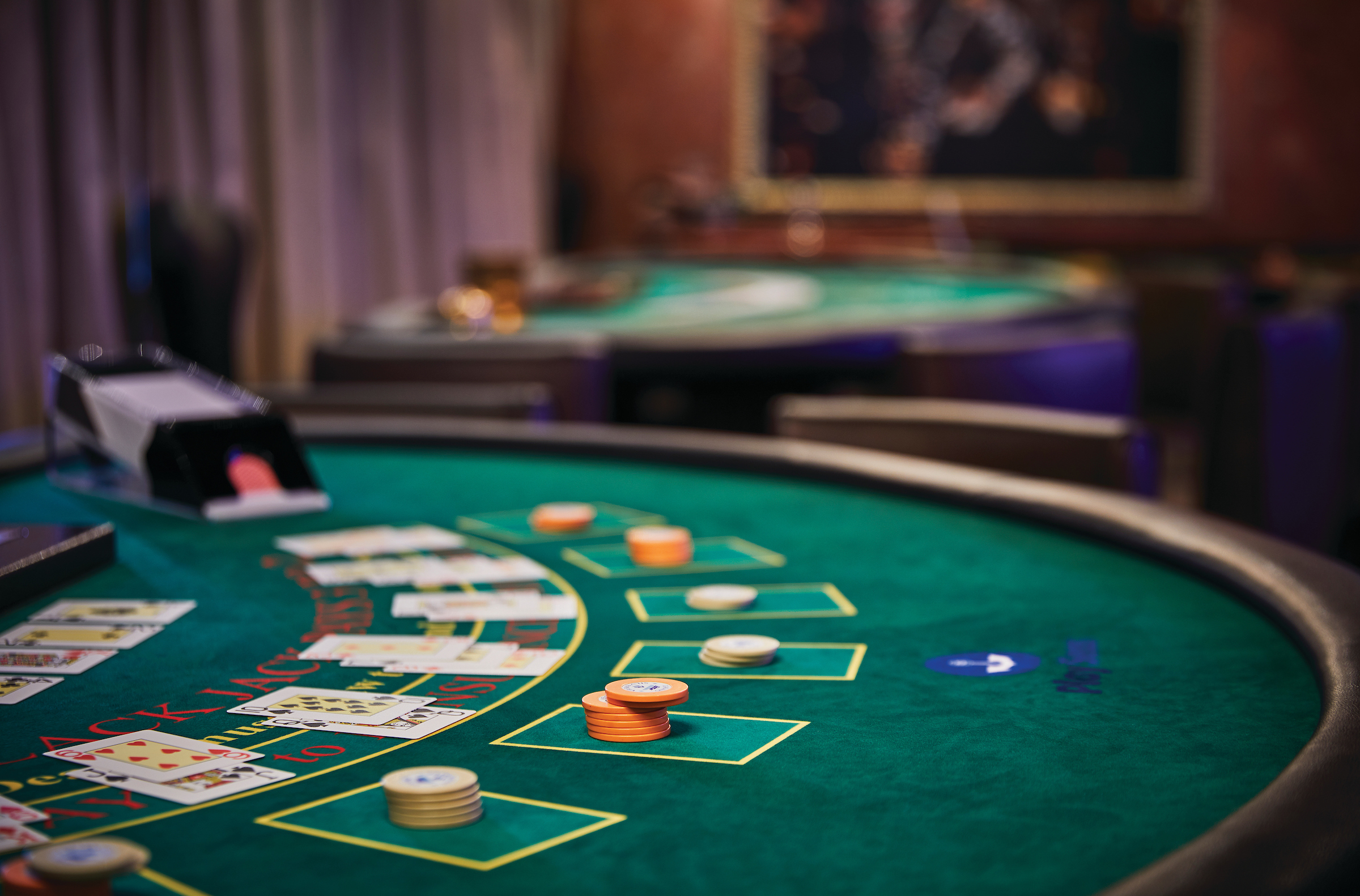
Let the fun begin! Channel your inner James Bond and enjoy a flutter at a variety of table games including American Roulette, Blackjack and Ocean Poker as Silver Dawn glides silently through the waves. An assortment of multi-game, multi-denominational reel and video slot machines are also available. Prepare yourself for a luxurious and exhilarating experience with every turn of a card and spin of the wheel. Game on!
Images are intended as a general reference. Features, materials, finishes and layout may be different than shown.

The grandeur and magic of music and theatre. The experience of being transported by performance. That satisfying feeling of seeing an evening show … Welcome to Venetian Lounge, a place where the arts of theatre and music meet with full-scale productions and feature films. Paying tribute to a golden age of glamour, Venetian Lounge offers belle-époque style cabaret seating, with intimate tables and chairs subtly placed between the rows of comfortable tiered banquettes. As the stage lights are dimmed, soak up the atmosphere, relax and enjoy a night of dazzling sights and sounds.
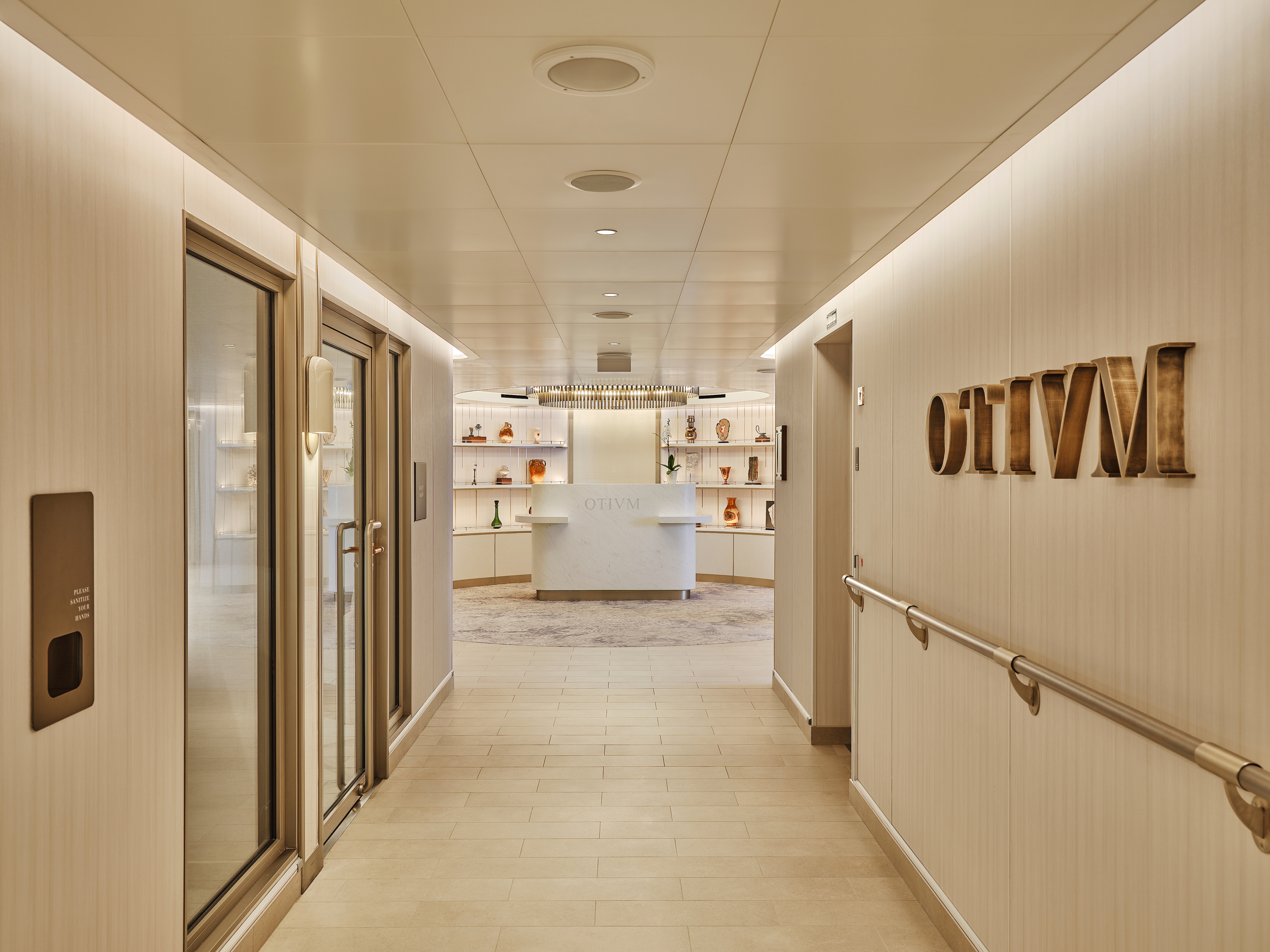
Finding relaxation is one the of the principle aims of taking a cruise, so why not join us in the Otium Spa for guaranteed indulgence? Turn off your phone, slip on your robe and get ready for a bit of me time. Whether you need to unwind with a massage, perk up your skin with a facial or work up a sweat in sauna and steam room, Otium Spa offers the very latest in beauty therapy. Make every day a special occasion in Otium Spa.
Images are intended as a general reference. Features, materials, finishes and layout may be different than shown.
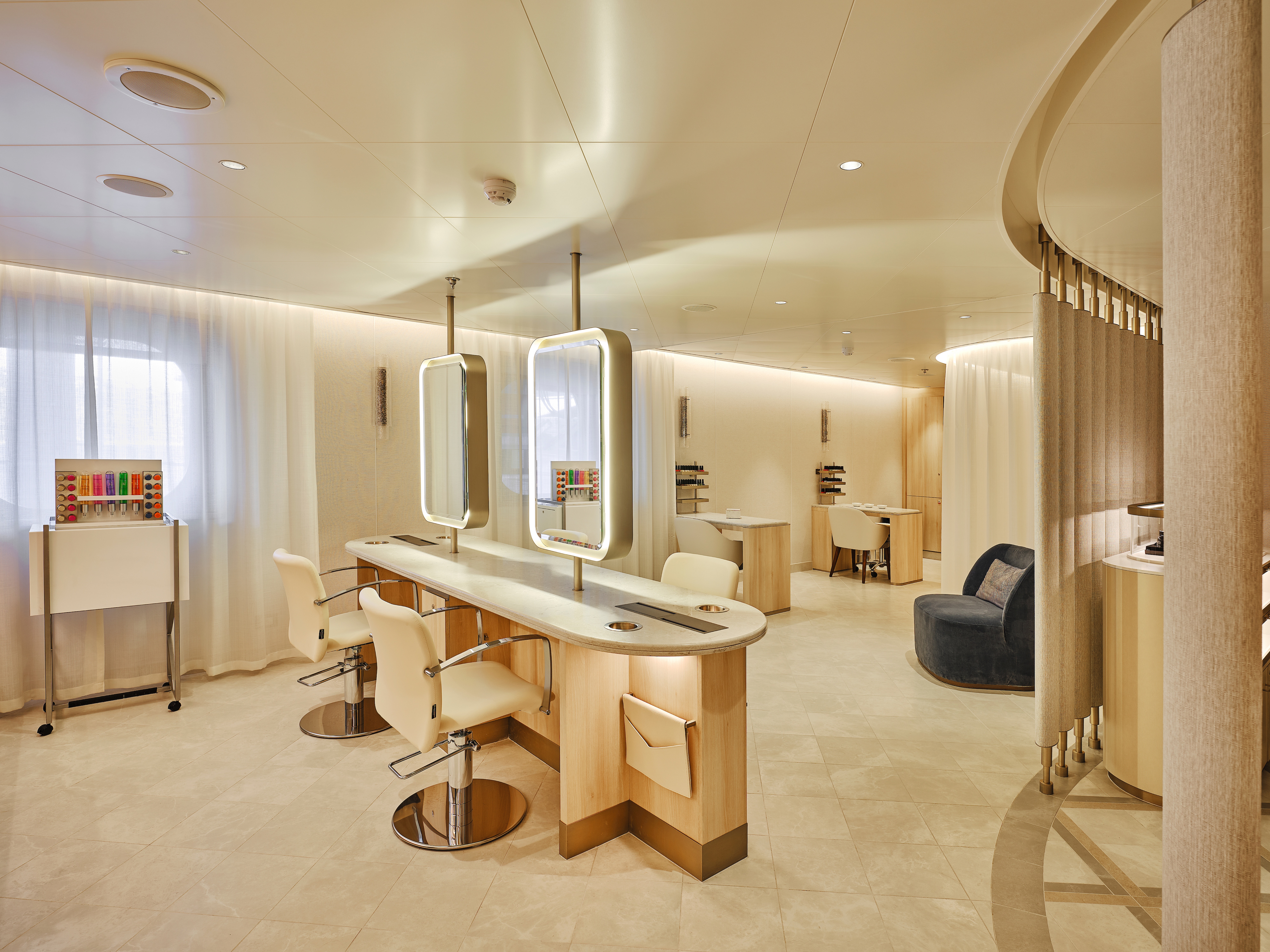
A full range of salon services including hairstyling, manicures and pedicures, is available on board this luxury cruise ship for both men and women. Appointments for these chargeable services may be made on board the ship, or in advance via My Silversea. Maintain the look of prestige travel while you cruise.
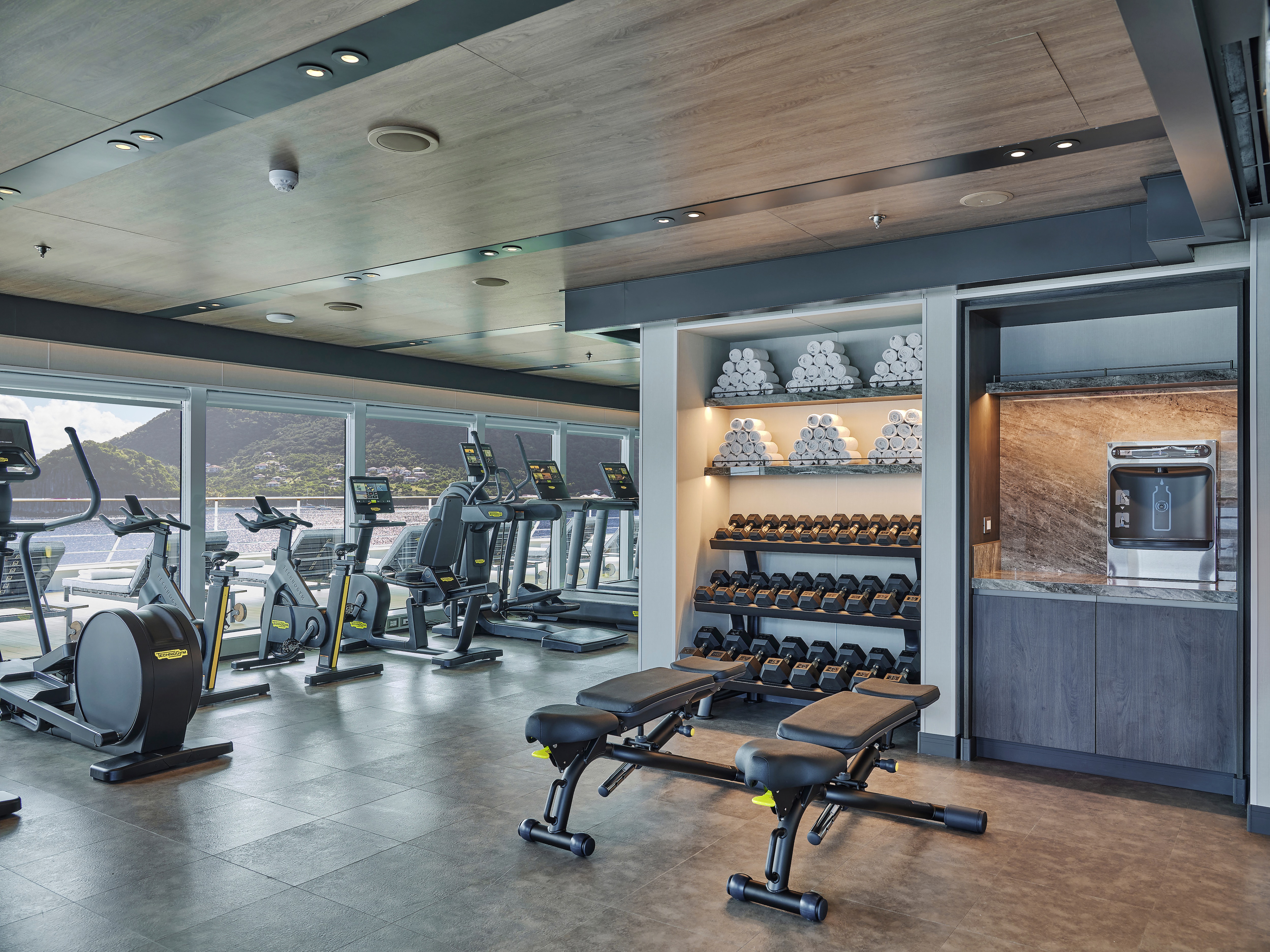
With state of the art Technogym® equipment, free weights and speciality classes, the Fitness Centre brings together elite design with programs that are specifically created for your body type and needs. With personal trainers available for individual sessions, training here is more a five-star experience for all levels of fitness and experience. And with the best view that you’ll ever get whilst working out, there are definitely no more excuses …
Images are intended as a general reference. Features, materials, finishes and layout may be different than shown.
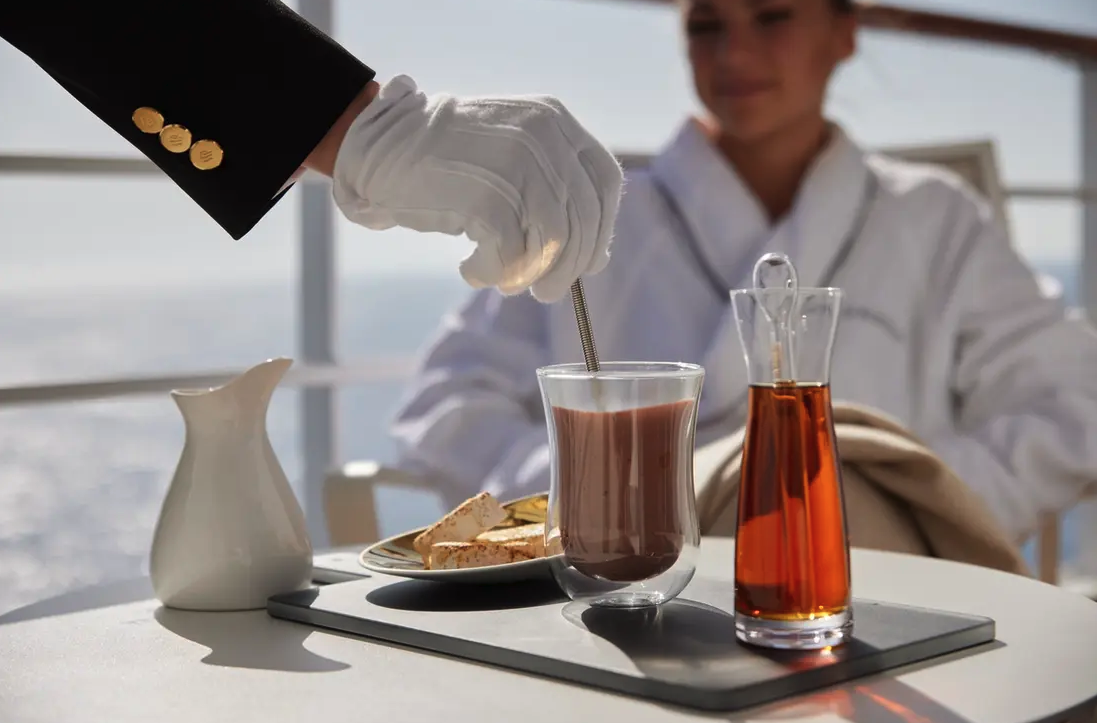
Enjoy Otium. Enjoy relaxation and wellness that goes from spa to suite. Enjoy the relaxing and indulgent world that makes every moment matter. In Otium, we believe that wellness and relaxation do not end in the spa, so we have extended our unique concept to permeate to all suites. Four tailor made in-suite experiences offer luxurious relaxation possibilities that are the embodiment of leisure and pleasure. Otium is far more than your average spa offering. Featured exclusively onboard Silver Dawn, with Otium you can dive deep, or float on the surface, it’s up to you. Debuting in Spring 2022.
The Otium Bathing Experience
Dissolve into the Otium bathing experience. Treat yourself to some well-deserved solitude with this indulgent addition to your voyage. No words can accurately describe this opulent experience. Perfect temperature bath water, comfortable back and neck pillows and bespoke bath salts from the Otium menu are just the beginning. Add candles, low level lighting, a delicious selection of delicacies to pamper the taste buds and the Otium music menu and we think you’ll agree that we have designed a superlative experience to soothe both body and mind.
The Otium Balcony Experience
We have curated three superb moments that promise deep immersion in your destination, from the comfort of your very own veranda. Each of the three moments is destination driven, depending on where you find yourself in the world. For sun lovers, enjoy “Under the Sun” – an enhanced your sun-bathing session that will pamper and protect in equimeasure! “Baby it’s cold outside” will bring extra-warmth during cold evenings and chilly climates with cashmere blankets and the first hot chocolate menu at sea. Finally, make your balcony your own, with personalisation with food and snacks by your butler.
The Otium Comfort Food Experience
“Food and Chill” takes our in-suite dining menu to a whole new level. Not only will the Otium Food and Chill experience feature all your favourite dishes from the on board restaurants – ideal for those who want to stay in to dine out, but this experience will also feature a selection of dining options designed to temp your tastebuds. Finally, the Movie experience will add a touch of class to your after dinner relaxation. Have luxury popcorn and nibbles delivered to your suite for an indulgent snack as you enjoy your insuite movie menu.
The Otium Sleeping Experience
Isn’t it time you became a successful sleeper? With the Otium Sleeping experience, you can choose a pillow from our vast pillow menu, curl up on 400 thread-count Egyptian cotton linens crafted exclusively for Silversea by Rivolta Carmignani and melt into a bespoke Otium mattress, designed exclusively for the ultimate sleeping experience at sea. What’s more, you can even ask your butler for our signature Otium sleeping scent, so ensure that you have the most restorative rest possible. Take a holiday from your alarm clock and enjoy the best night’s sleep of your life.
During the day, casual wear, similar to five-star resort sportswear, is suitable for most activities. It is recommended to wear flat or low-heeled shoes on deck.
After 6 pm, our Evening Dress Code applies; jeans, shorts, sneakers, or flip-flop-type footwear are prohibited in indoor spaces.
TWO EVENING TYPES:
1. Elegant Casual
Ladies may opt for trousers, a blouse, skirt, or casual dress. Gentlemen may wear an open-collar shirt and slacks. A jacket is optional.
2. Formal Optional
Ladies may choose an evening gown or cocktail dress. Gentlemen should wear a tuxedo, dinner jacket, or dark suit with a tie. Adhering to our Elegant Casual dress code is also welcomed, but a jacket is still required for gentlemen when indoors
FORMAL OPTIONAL NIGHTS PER SAILING:
- 7 days or less – No Formal Optional night
- 8 to 14 days – 1 to 2 Formal Optional nights
- 15 days or more – 2 or more Formal Optional nights
Wheelchair guests must bring their own collapsible wheelchair. Please note that not all shore excursions are suitable for guests with impaired mobility. Silversea strongly recommends wheelchair guests travel with someone who is able to assist them both ashore and at sea as Silversea may be unable to offer special assistance. Please note that wheel-on and/or wheel-off access may not be available at some ports-of-call. Silversea reserves the right to deny boarding to any guest who failed to notify Silversea of such requirement at the time of booking.
All guests are required to report in writing to Silversea at the time their reservation is made:
- Any physical or mental condition that may require medical or professional treatment or attention during the voyage
- Any condition that may render the guest unfit for travel, or that may require special care or assistance
- Any condition that may pose a risk or danger to the guest or anyone else on board the ship
- Any condition that may require oxygen for medical reasons
- Any intention or need to use a wheelchair aboard ship.
If you have special dietary requirements, Silversea will make every attempt to accommodate your requests. Please advise Silversea of your needs on the Guest Information Form at least 75 days prior to sailing. Notification should be sent to specialservices@silversea.com
Each Silversea ship is equipped with a Medical Centre, which is staffed by a doctor and nurse on 24-hour call when at sea. When docked, supplementary emergency care may also be obtained through local medical facilities. Guests may be charged for medical services and for medications used for their medical treatment. The Medical Centre is not intended or designed to provide on-going treatment of pre-existing conditions or for extended critical care, and Silversea is not responsible for the diagnosis, treatment or services furnished by shipboard medical personnel.
Silversea cruise guidelines state that children under the age of 18 must be accompanied, in the same or connecting suite, by a parent or other responsible adult over the age of 21 for the duration of the voyage. If the adult accompanying the minor is not their parent, a parental consent guardianship form must be signed by a parent or legal guardian and received by Silversea prior to sailing. Please contact our Special Services Department at SpecialServices@Silversea.com for a Parental Consent Form. Guests must be 21 years of age or older to purchase or consume alcohol. Silversea reserves the right to refuse to serve anyone who in its sole judgment may be under the influence of alcohol, or for any reason necessary in its judgement to preserve the health and safety of guests and employees.
Silversea cannot accommodate infants less than six months of age and reserves the right to limit the number of children less than three years of age (Silver Explorer, Silver Cloud and Silver Wind cannot accommodate infants under the age of 1 year, Silver Origin cannot accommodate children under the age of 5 years). Parents are required to sign a notarised waiver prior to sailing in order to grant a valid booking for children ages between 6 months and 1 year old. A signed and notarised waiver will be required for all children between these ages. Although Silversea accepts guests over the age of 6 months (over the age of 1 year for Silversea Expeditions), there are no special programmes for children on board our luxury cruise ships, and Silversea does not provide for the care, entertainment or supervision of children. Silversea reserves the right to limit the number of children less than 3 years of age.
Children under the age of 8 years old are only permitted to participate in suitable Silver Shore Excursions / shuttle service if the vehicles are equipped with the correct safety harness and seating equipment. Child harnesses and secure seating cannot be guaranteed. Silversea reserves the right to refuse children under the age of 8 years old on any tour on the basis of safety. Guests may use their own approved safety seat, booster seat or harness provided they are compatible with the local touring vehicle and can properly secure the child.
In addition, the Zodiacs used for Silversea Expeditions are unable to accommodate children younger than 5 years of age. As Silversea does not provide babysitting services, an adult family member will be required to remain on board with their child(ren) during Zodiac excursions.
At Silversea, the comfort, enjoyment and safety of all guests is paramount. To ensure a pleasant and safe environment, smoking is prohibited in most public areas, guest suites or suite balconies. However, cigarette, e-cigarette, cigar, pipe and vaporizer smoking is permitted in the Connoisseur’s Corner both indoors and outdoors (where applicable). In addition, cigarette, e-cigarette and vaporizer smoking is permitted in specifically designated outside areas and tables:
- Silver Nova, Silver Ray: Dusk Bar (port side);
- Silver Muse, Silver Spirit: Panorama Lounge (port side) and Pool Grill (port side);
- Silver Moon, Silver Dawn: Panorama Lounge (starboard side) and Pool Grill (port side);
- Silver Shadow, Silver Whisper: Panorama Lounge (starboard side) and Pool Grill (starboard side);
- Silver Cloud, Silver Wind: Panorama Lounge (port side) and Pool Grill (port side);
- Silver Origin: on open deck 4 aft;
Silversea kindly requests that all guests observe the non-smoking areas.
Complete valet services, including laundry, pressing and wet cleaning, are available at an additional charge and may be arranged through your butler. Laundry service is complimentary for certain suite categories and for those Venetian Society members who have reached certain reward levels. A self-service launderette offers washing machines, dryers, irons and laundry supplies, allowing you to limit the amount of cruise luggage needed, especially for longer voyages.
All Silversea ships are equipped to offer wireless (Wi-Fi) Internet access. You can use your own laptop to surf the Internet and check emails at Wi-Fi locations throughout the ship, or from the comfort and privacy of your suite. Computers, email and Internet access are also available on board at the Internet Café. However, it is important to understand that telecommunication services while at sea are via satellite and significantly different than high-speed connections on land back home. The signal travels in a similar manner to radio waves but at much greater distances. Therefore, onboard Internet access is not guaranteed at all times. Satellite communications are also affected by weather and the ship’s location. In particular, Internet service is extremely sporadic while in the Arctic. Guests aboard expedition cruises to/from Svalbard should be prepared to be out of communication for the duration of their time on board. (Please be assured that Silver Explorer always has emergency communication capabilities.)

- Observation Library
- Spaccanapoli
- Jogging Track
- Silver Suites
- Elevator

- Pool Deck
- Pool Bar
- Launderette
- The Grill
- Whirlpool Area
- Silver Suite
- Elevator

- Panorama Lounge
- Connoisseur’s Corner
- Connoisseur’s Outdoor Area
- Launderette
- Owner’s Suite
- Panorama Suite
- Silver Suite
- Superior Veranda Suite
- Grand Suite
- Elevator

- Arts Café
- Boutique
- La Dame
- Launderette
- Deluxe Veranda Suite
- Superior Veranda suite
- Grand Suite
- Elevator

- La Terrazza
- Silver Note
- Casino
- Launderette
- Royal Suite
- Superior Veranda Suite
- Deluxe Veranda Suite
- Elevator

- Otium Spa
- Fitness Centre
- Relaxation Area
- Beauty Salon
- Launderette
- Deluxe Veranda Suite
- Classic Veranda Suite
- Elevator

- Reception/Guest Relations
- Shore Concierge
- Dolce Vita
- Venetian Lounge
- Future Cruise Sales
- Launderette
- Cruise Consultant
- Classic Veranda Suite
- Elevator

- Atlantide
- Kaiseki
- S.A.L.T Kitchen
- S.A.L.T Bar
- S.A.L.T Lab
- Vista Suite (3x Accessible)
- Elevator

